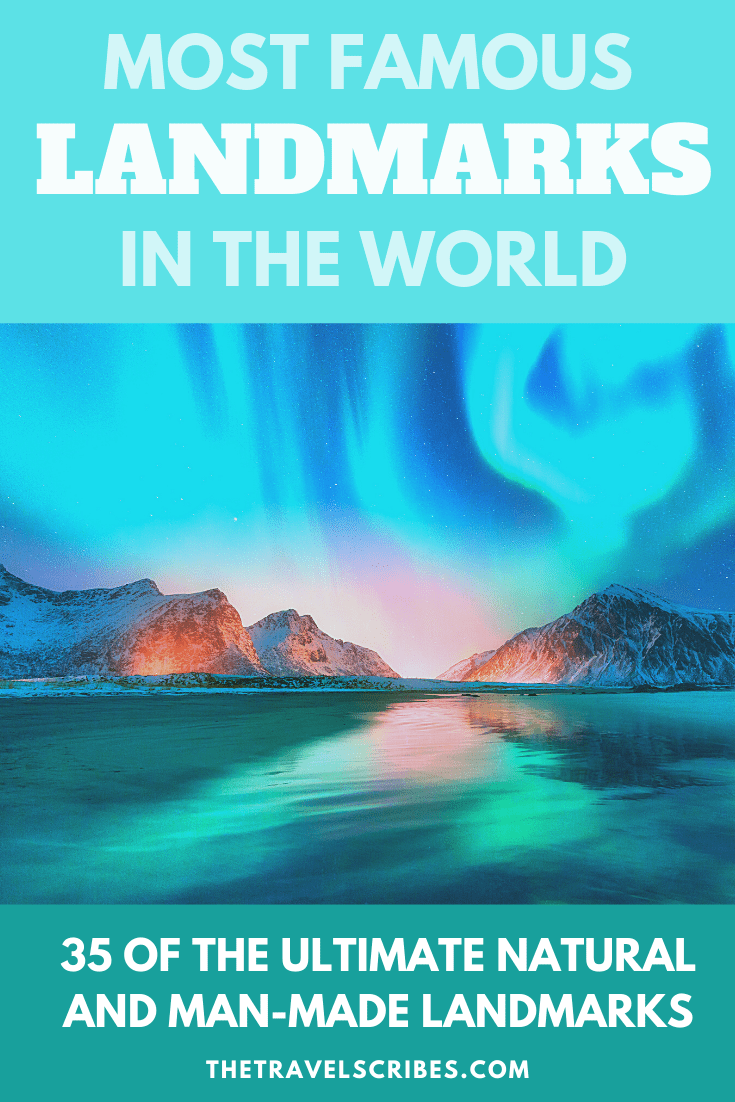We’ve counted down some of the most incredible buildings, mind-blowing landscapes and famous landmarks from many countries so we thought it was about time we put together the ultimate list of famous landmarks from around the world.
And in no ways has this been an easy task! Over at The Travel Scribes HQ we have been debating nonstop on this one but somehow, we’ve managed to narrow it down to a list of (what we think are) the top 35 landmarks on the planet. And of course, there were multiple landmarks that just didn’t quite make it. Do you think we’ve really missed one of the most famous landmarks from around the world off this list? Let us know in the comments below!
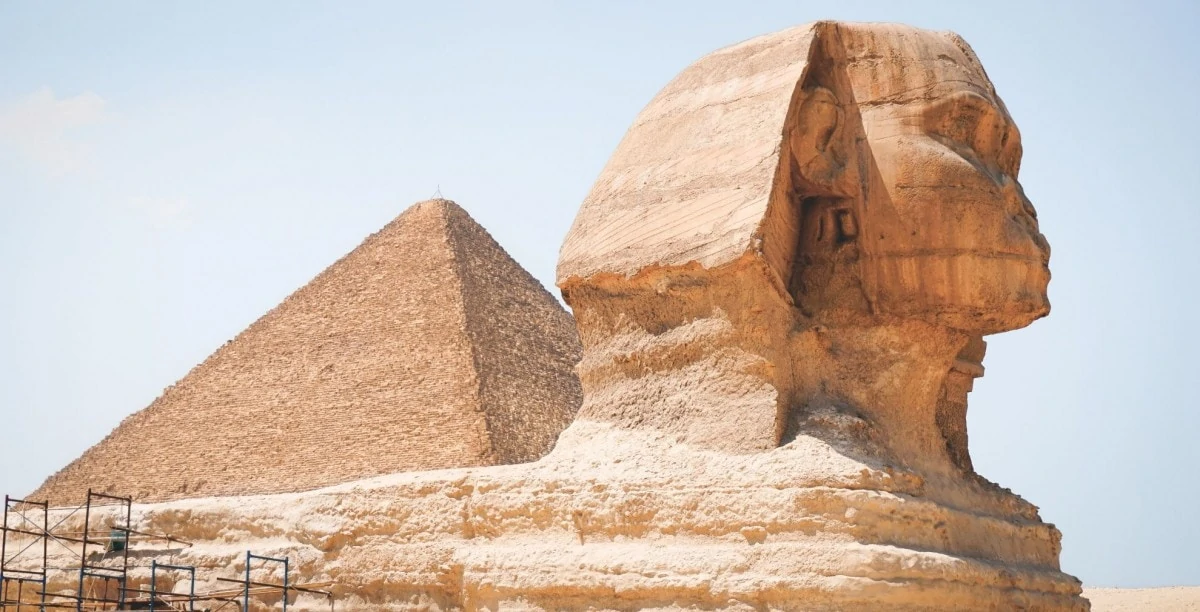
Skip ahead
Top 10 man made famous landmarks
While we have a long list of 35 landmarks, we thought we’d count down a (hotly contested) list of the top ten man-made landmarks. These legendary monuments and attractions are feats of engineering:
- The Pyramids
- Statue of Liberty
- Taj Mahal
- The Great Wall of China
- Angkor Wat
- Eiffel Tower
- Machu Picchu
- Burj Khalifa
- Colosseum
- Easter Island statues
Top 10 natural famous landmarks
Again, not easy to do but we’ve tried to condense thousands of the best naturally occurring landmarks into a top 10. Don’t agree? Read on for our longer list of the most spectacular places in nature.
- Table Mountain
- Great Barrier Reef
- Mount Everest
- Grand Canyon
- Victoria Falls
- Amazon Rainforest
- Sahara Desert
- Niagara Falls
- Northern Lights
- Dead Sea
Africa
Man-made landmarks
The Pyramids

We have to kick off the list with a landmark that includes the only lasting entry from the original 7 wonders of the world – The Great Pyramid of Giza near to Cairo.
The Egyptian pyramids (there are actually over 100 of these incredible structures) are on the most part ancient tombs built by the pharaohs with some dating back over 5,000 years.
The largest of these pyramids, the Great Pyramid also known as the Pyramid of Khufu contains around 2.3 million blocks and is estimated to have taken between 10 and 20 years to build. The structure is so big that it stood as the tallest man-made object for around 3,800 years. To put that in perspective, that would be the same as the Burj Khalifa, the current tallest building on earth, lasting as such until the year 5810.
The fact that structures like the Egyptian pyramids could be built with such precision and to such scales all those years ago is still mind-blowing.
Natural landmarks
Victoria Falls
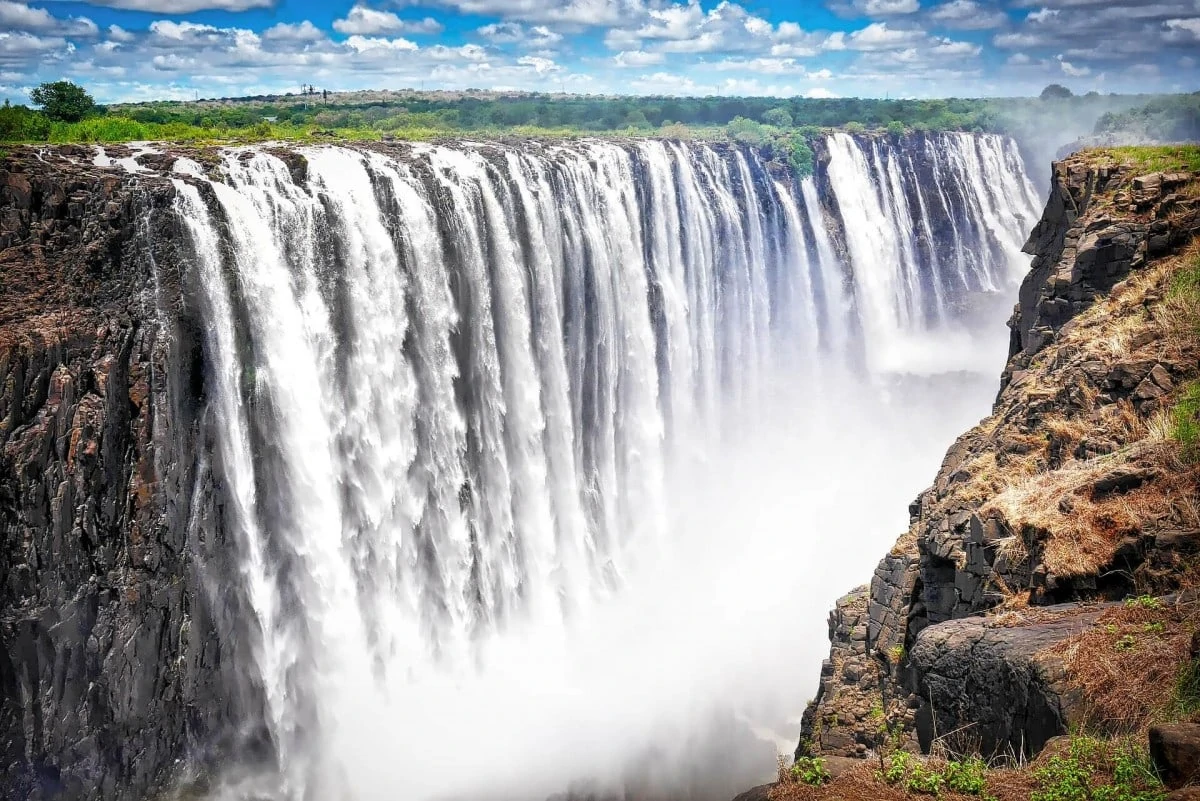
Double the height of Niagara Falls and almost 50% wider, Victoria Falls is one of the most awe-inspiring places in the world and definitely makes it onto our list of famous landmarks as one of the most stunning places on earth.
The waterfall on the Zambezi River bordering both Zimbabwe and Zambia is probably only rivalled in pure scale by the great Iguazu Falls that lies on the border between Argentina and Brazil. And unsurprisingly both sites have been awarded the status of UNESCO world heritage site.
The waterfall was named by David Livingstone, the Scottish explorer who is believed to have been the first European to see the waterfalls in 1855 – he named it after Queen Victoria.
Think you know your landmarks? Then why not check out these famous landmark quiz questions.
Table Mountain
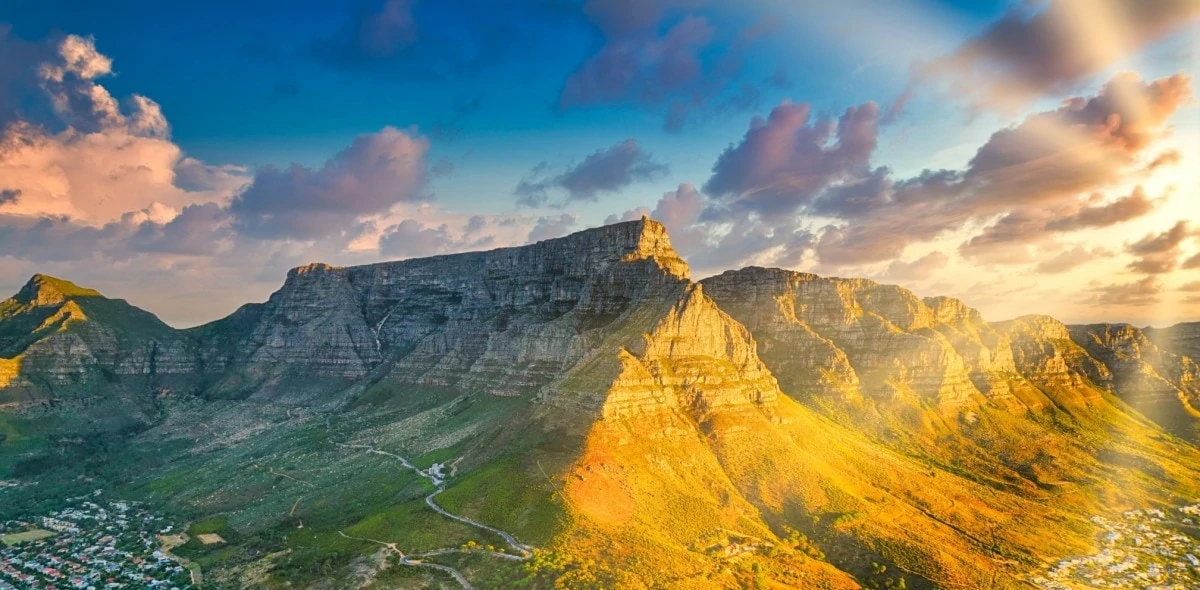
If you think of Cape Town, the first thing that springs to mind is Table Mountain. It’s the most iconic landmark in the city, if not all of South Africa and adorns the front of brochures and postcards across the globe.
Characterized by the layer of mist, the ‘table cloth’ that often clouds over its surface, Table Mountain got its name – unsurprisingly – from it’s shape. However, it’s the two mountains flanking it that have more unusual beginnings, with Signal Hill so named as it was home to signal flags for arriving ships. The other mountain, Lion’s Head, obviously shaped like a lion.
Table Mountain’s signature level plateau stretches three kilometres from side to side, making it an imposing structure with a unique shape. A mecca for tourists, millions of travellers ascend on the cableway each year while avid hikers like spending time walking it’s slightly challenging trail.
Interesting fact: Table Mountain is part of the Cape Floristic Region, a small area of the peninsula home to it’s own floral kingdom, ‘fynbos’. Essentially ‘fynbos’ is one of six of the world’s biodomes and is only found in this small corner of the world.
Serengeti
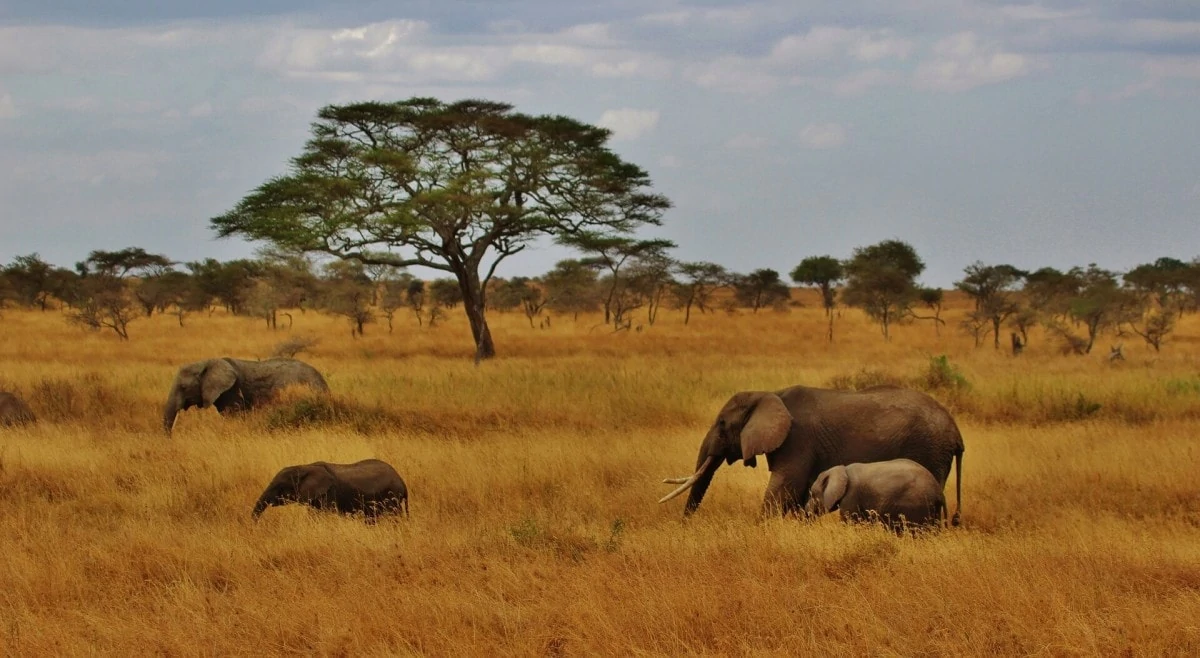
We had a real tough choice in nominating one of the great safari areas onto this list, when you have household names like the Masai Mara in Kenya, the Kruger National Park in South Africa and the Okavango Delta in Botswana in the mix (which interestingly, the latter was the 1000th UNESCO world heritage site).
But for us there was one clear winner – the great plains of the Serengeti in Tanzania – which has also made it on to numerous natural wonders of the world and natural wonders in Africa lists.
And for us this famous landmark is also partly on the list for the great wildebeest migration that takes place every year, with around 250,000 zebra, 1.7 million wildebeest and almost half a million gazelles migrating across the great plains, making their way from the south of the Serengeti towards the Masai Mara.
The River Nile
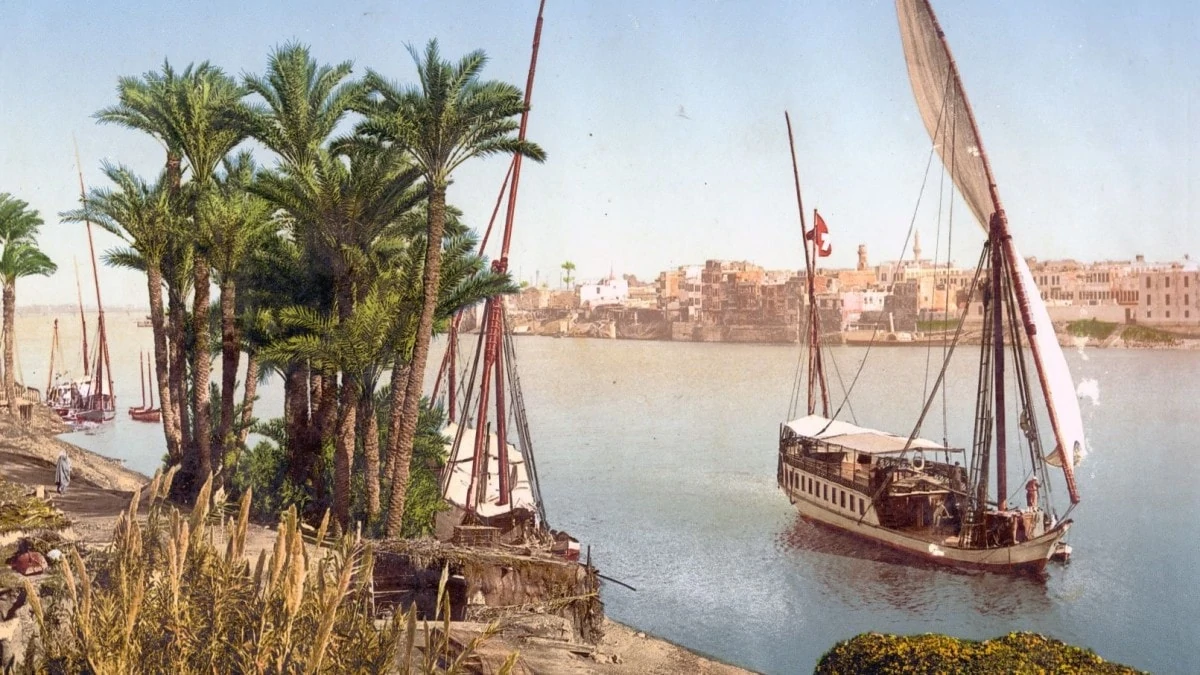
The only river to make it onto our world-famous landmarks list is the longest on the planet: the River Nile.
At over 6650 km long (that’s more than 4,100 miles), the Nile is the drainage basin for around 10% of Africa. It flows through 11 countries, from the hills of Rwanda (or disputedly Burundi), the African Great Lakes, across the Sahara Desert, before emptying from the Nile Delta into the Mediterranean.
Interesting fact: There is actually more than one Nile! The White Nile and Blue Nile, the White Nile is the longest, joining the Blue Nile near Khartoum.
Sahara Desert
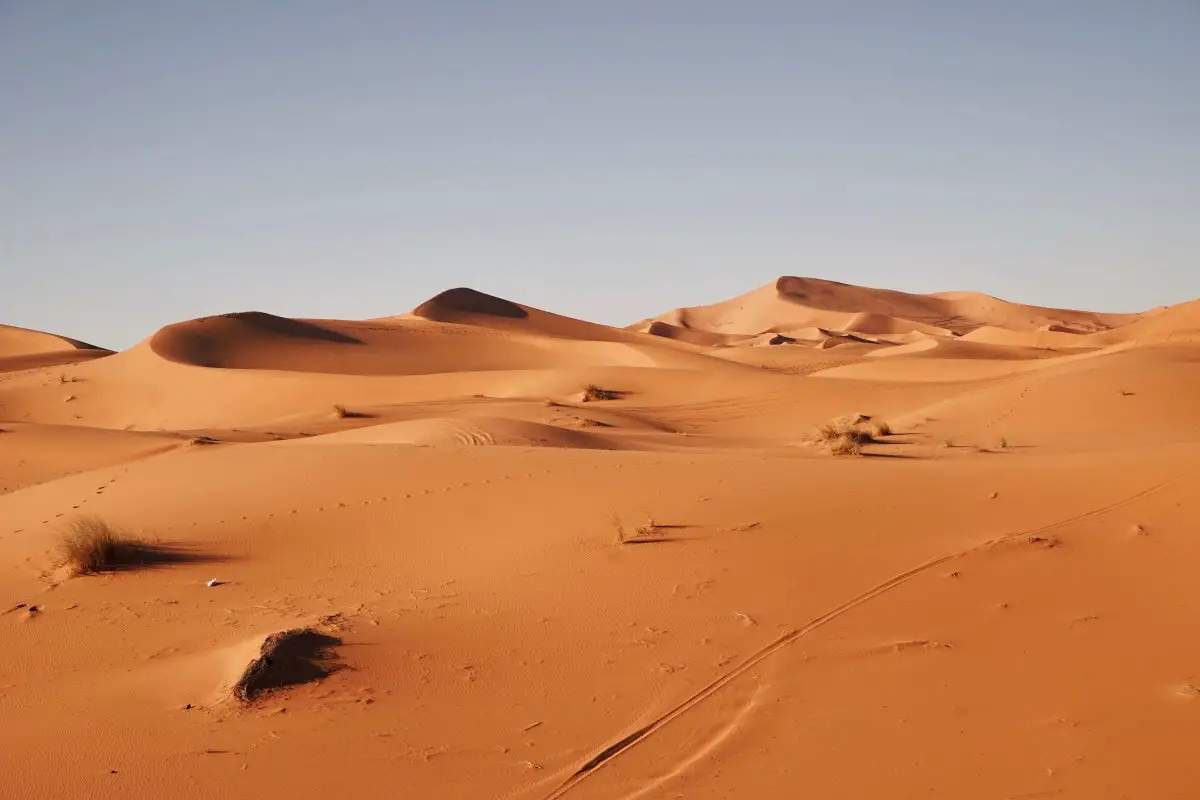
One of our favourite travel quiz questions is ‘what is the largest desert in the world’, as the majority of people will always answer with ‘the Sahara’ – we’re all taught that at school after all. But in fact it’s wrong, technically the largest deserts in the world are the Antarctic followed by the Arctic, with the Sahara coming in a lowly third.
But let’s be honest, the Sahara is an absolutely iconic landmark that covers much of Northern Africa, East Africa and the Middle East, and as far as the traditional ‘dry deserts’ go, it’s an absolute monster, weighing in at about 3 times the size of its nearest competitor – the Australian Outback.
It’s so big that this dry desert covers around 30% of the world’s second largest continent, and although barren it produces some of the most stunning scenery you’ll ever find.
Fascinating fact: The Sahara alternates between dry desert and green savannah, with the change occurring every 20,000 years, this happens due to the change of the North African monsoon based on the precession of the earth’s axis. But the next change is only in 17,000 years or so…
Asia
Man-made famous landmarks
Taj Mahal
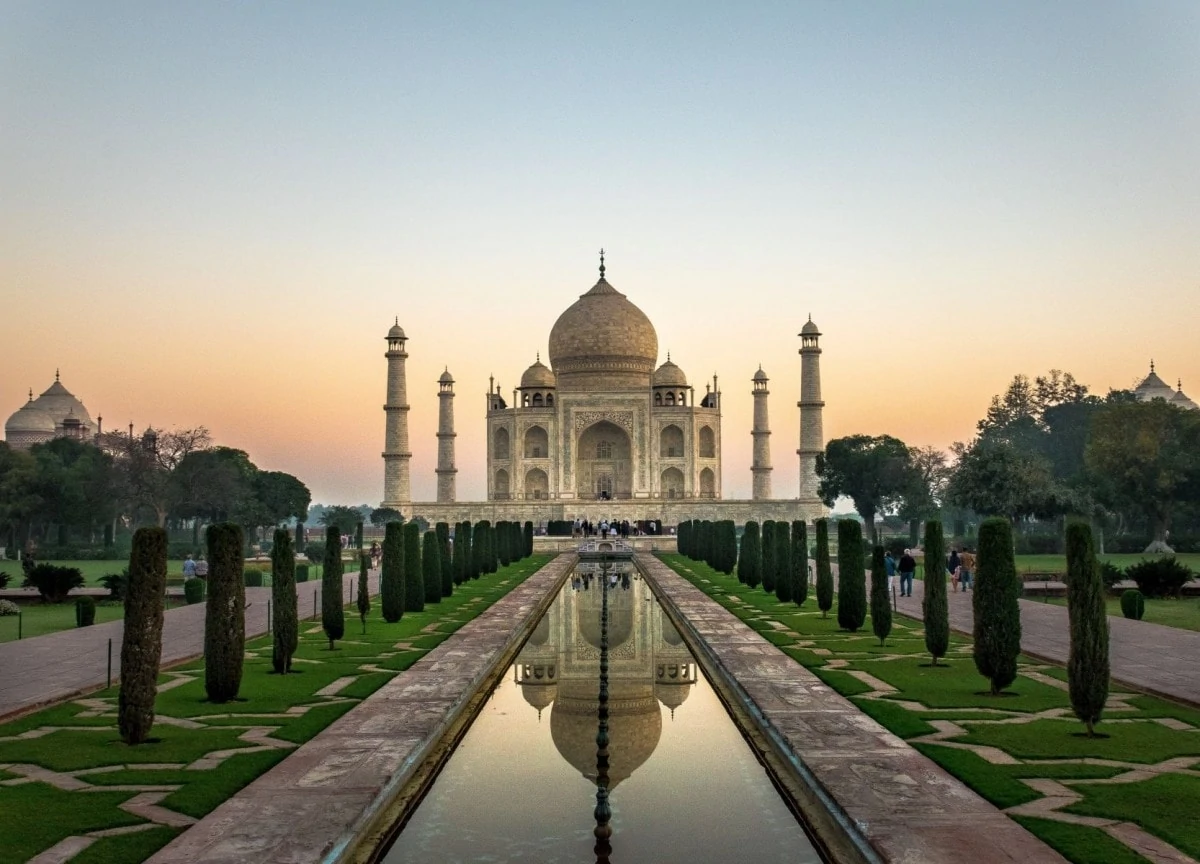
Another tomb to make it onto the famous landmarks list, the Taj Mahal is undoubtedly one of the stunning wonders of the world, and one of those bucket-list items we sadly haven’t managed to check off yet.
This UNESCO world heritage site was actually constructed by Emperor Shah Jahan as a mausoleum for his favourite wife, Mumtaz Mahal. Completed in 1643, this white marble structure sits on the banks of the Yamuna river in Agra, India.
Fact or fiction: The legend that Emperor Shah Jahan had planned a replica ‘black’ Taj Mahal on the opposite banks of the Yamuna River are supposedly a myth!
Angkor Wat
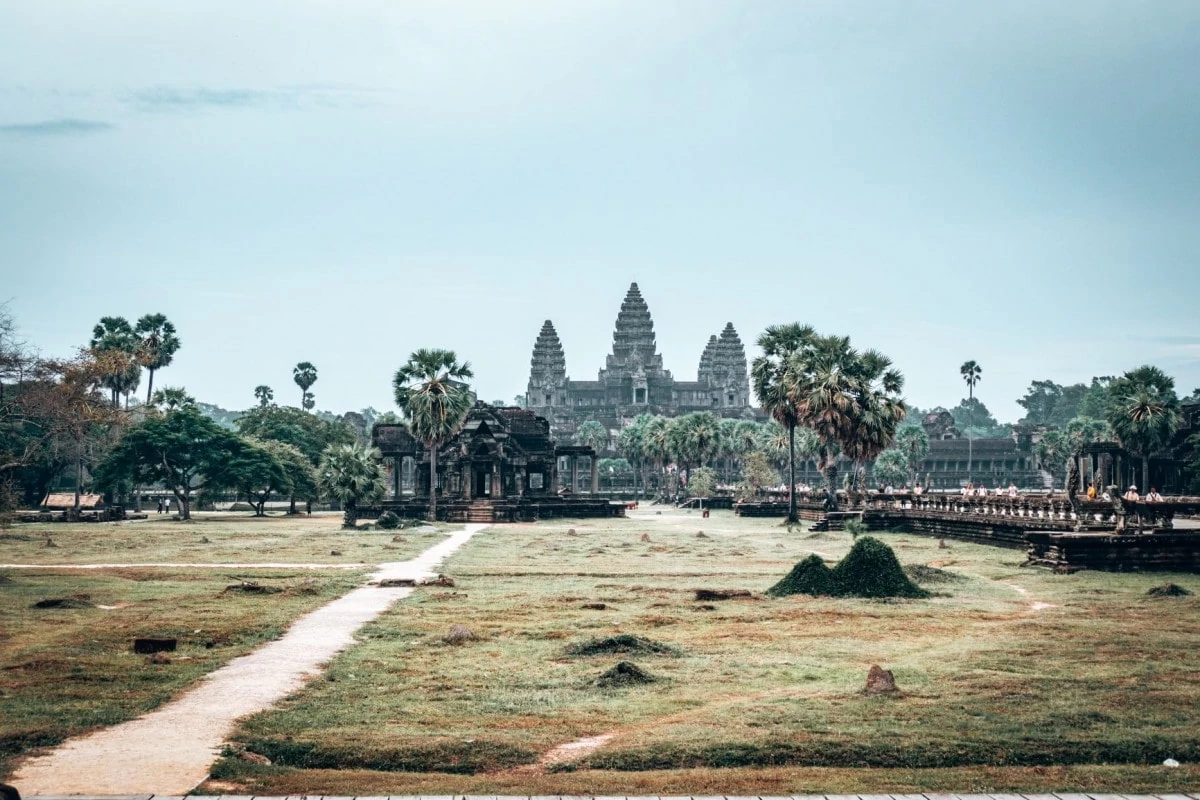
So much a symbol of Cambodia that this stunning landmark sits in the middle of its country’s flag. In fact, we can’t think of another flag that has a man-made landmark on it!
The size of Angkor Wat is mind-boggling, it’s actually the largest religious monument in the world at 1.6 square km (over 400 acres), and it’s even more impressive when you find out that it was built back in the 12th century!
In our opinion only rivalled by the great temples of Bagan, Angkor Wat was originally constructed as a Hindu temple, during the Khmer Empire, before being gradually transformed into a Buddhist temple.
Looking for some more inspiration about some of the great landmarks in Asia? We’ve got a whole host of amazing landmarks and iconic building to explore when visiting Indonesia, Myanmar, Singapore, Thailand, Vietnam, Sri Lanka and Malaysia!
Great Wall of China

Possibly our personal favourite in the man-made famous landmarks category is the Great Wall of China. And that’s in no small part because we managed to spend a couple of days exploring the unrestored Gubeikou and restored Jinshanling sections of the wall. It is just an incredible structure.
The scale of the Great Wall of China is also just so hard to understand… the total length of the wall is around 21,000 km (that’s over 13,000 miles or more than halfway around the world). If you were to walk 20 km a day, without any days off it would take you just shy of 3 years to cover its length.
Add to that fact that it was built over 2,000 years ago and is estimated to have needed over 1 million people to work on it, and you’ll start to understand how unbelievably impressive this landmark is.
If it’s not on your travel list – make sure you add it.
Interested in other landmarks in China? We’ve explored the best that China has to offer in our China landmarks piece.
Natural landmarks
Mount Everest
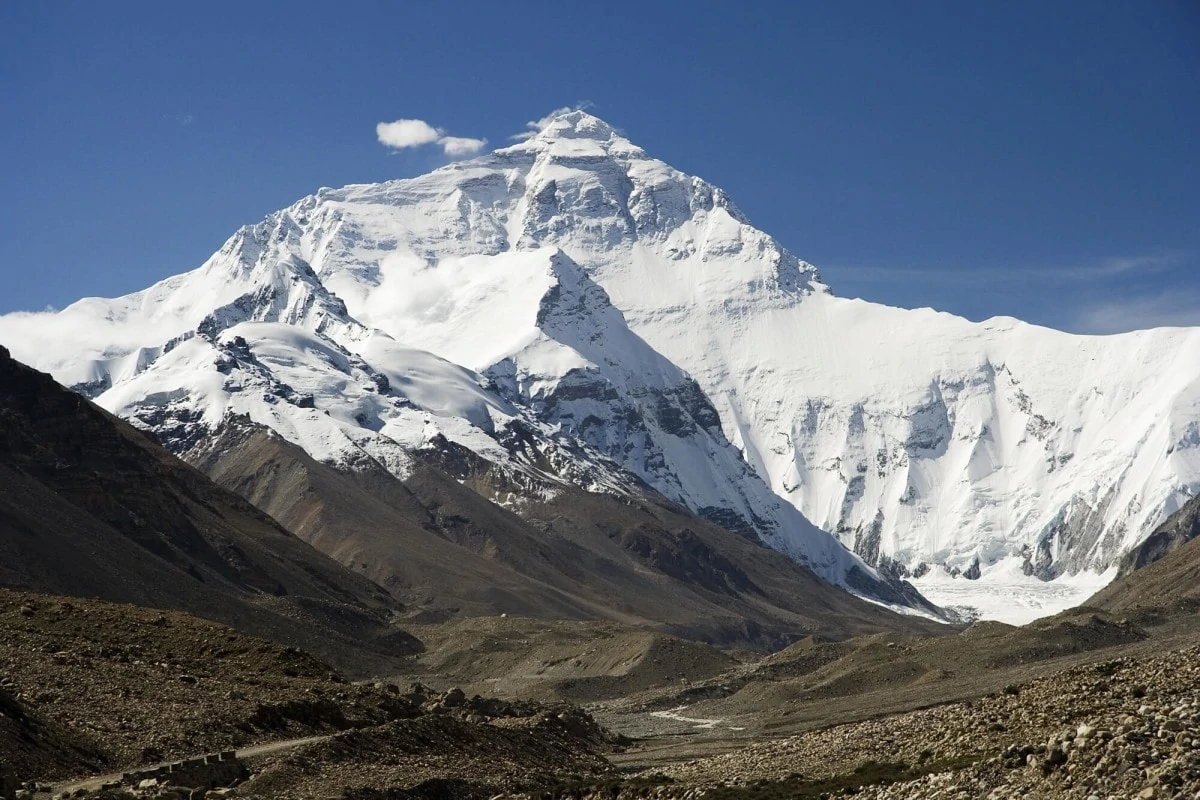
Not sure how much of an introduction is needed for the tallest mountain on our planet… but here goes. At 8,848 metres in height, weighing in at a lot, and not scaled until 1953 by Norgay and Hillary, Everest has to be one of the great landmarks on earth.
Named after Sir George Everest, the former Surveyor General of India, by 2010 over 5,000 successful ascents of the behemoth had been recorded. And with numbers of attempts increasing over the years, this has led to overcrowding issues on the mountain.
Fun fact: The China and Nepal border actually runs across the summit of Mount Everest!
Zhangjiajie National Park
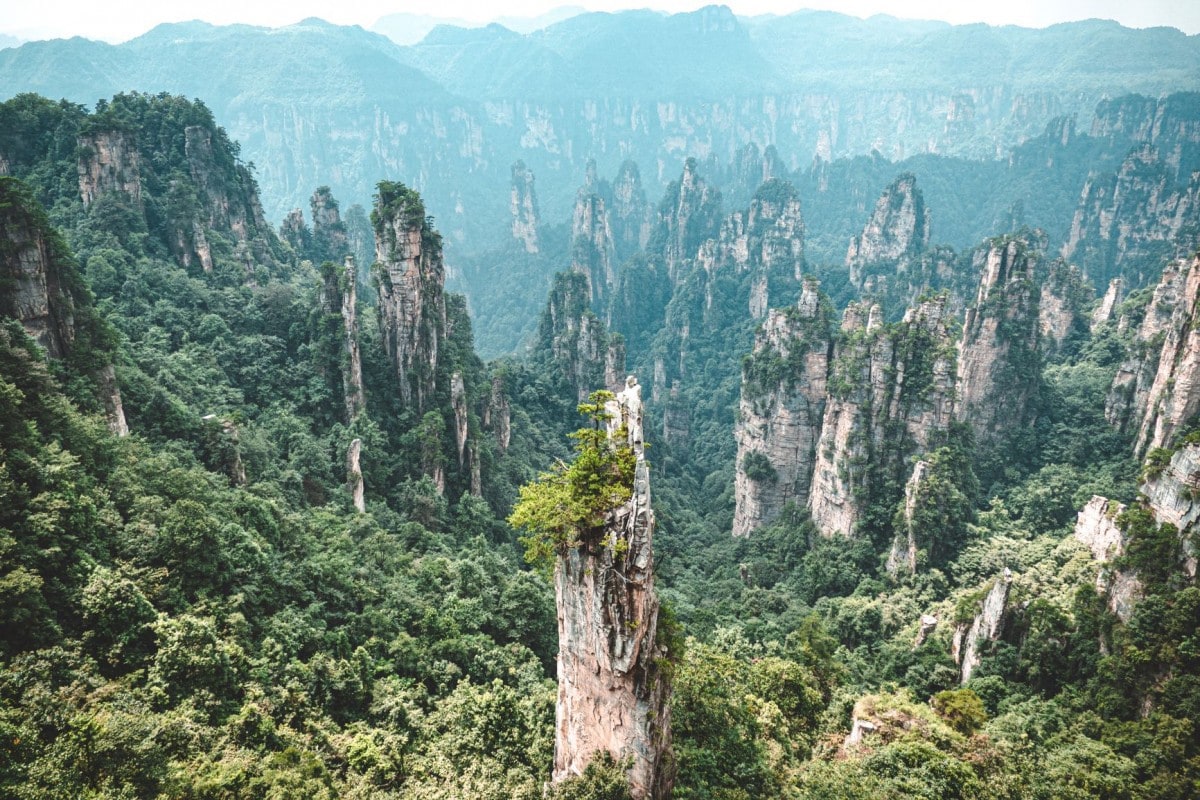
Another furious debate raged on whether to include Zhangjiajie (and the Wulingyuan Scenic Area) in China into the famous landmarks list. But we felt that it’s as impressive as the Grand Canyon in the US, so if that made the list, so does Zhangjiajie.
So, it may not be as ‘famous’ as many of the others in this list, but when around a billion Chinese people know of the area, it’s still got to be on here right?
And what’s more, is that if you haven’t heard of these mountains, you may well have seen them or depictions of them and not known what they are… as the Avatar Hallelujah Mountains (part of Zhangjiajie) are known is the inspiration for the floating mountains in James Cameron’s blockbuster film Avatar.
The national park is over 400 square km in size, with breath-taking landscapes punctuated by limestone karsts. So, another landmark that you need to have on your must-go-to list.
Want to know more about the Zhangjiajie National Park, here is our guide to this mesmerising national park.
Mount Fuji
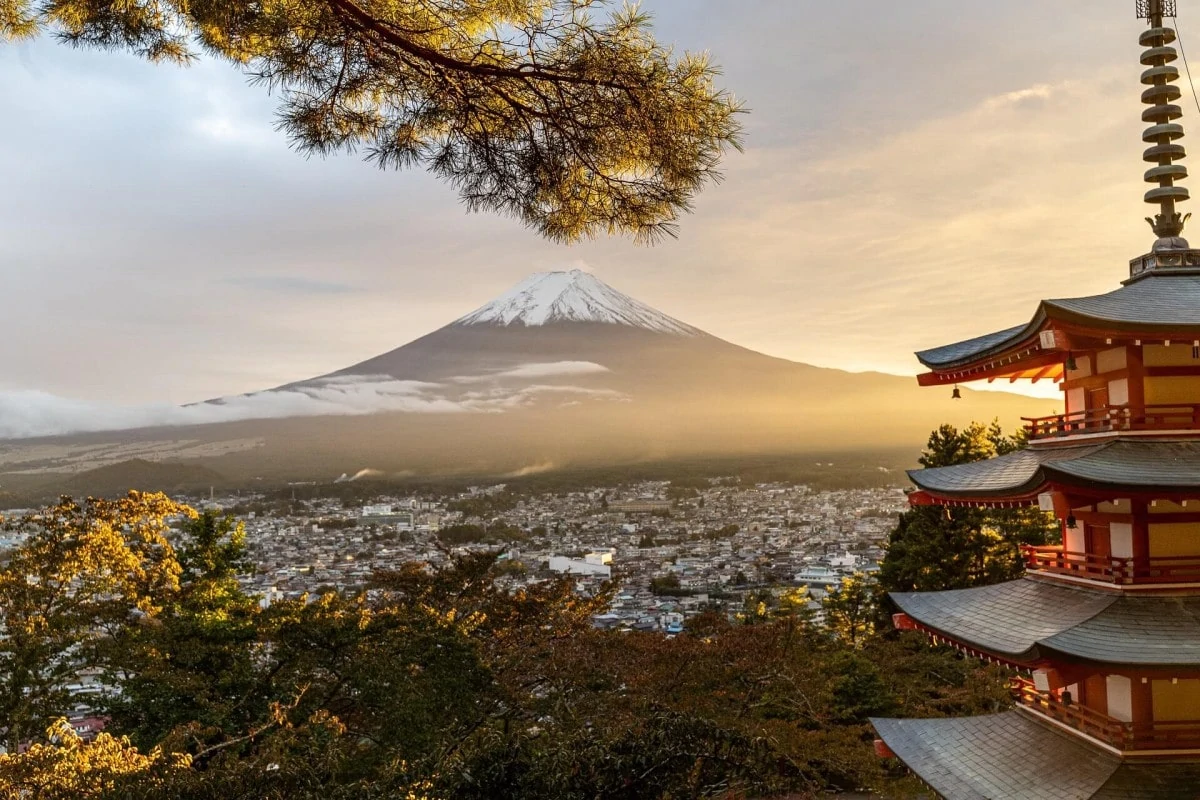
On a clear day, this active volcano can be seen from Tokyo – surprising given that it’s around 100 km (over 60 miles) away from Japan’s capital.
What’s most striking about Mount Fuji is its perfect cone shape, which is actually pretty rare. Although if you were asked to draw a volcano, this would be your go-to shape. Even more interesting is that this famous landmark is actually classed as a stratovolcano (we had to look that one up), and it’s not just a single volcano, but three on top of each other, with Mount Fuji on the top.
Fact: Mount Fuji is the highest mountain in Japan at 3,776 metres, and although an active volcano, hasn’t erupted for the last 300 years.
Australasia
Man-made landmarks
Sydney Opera House
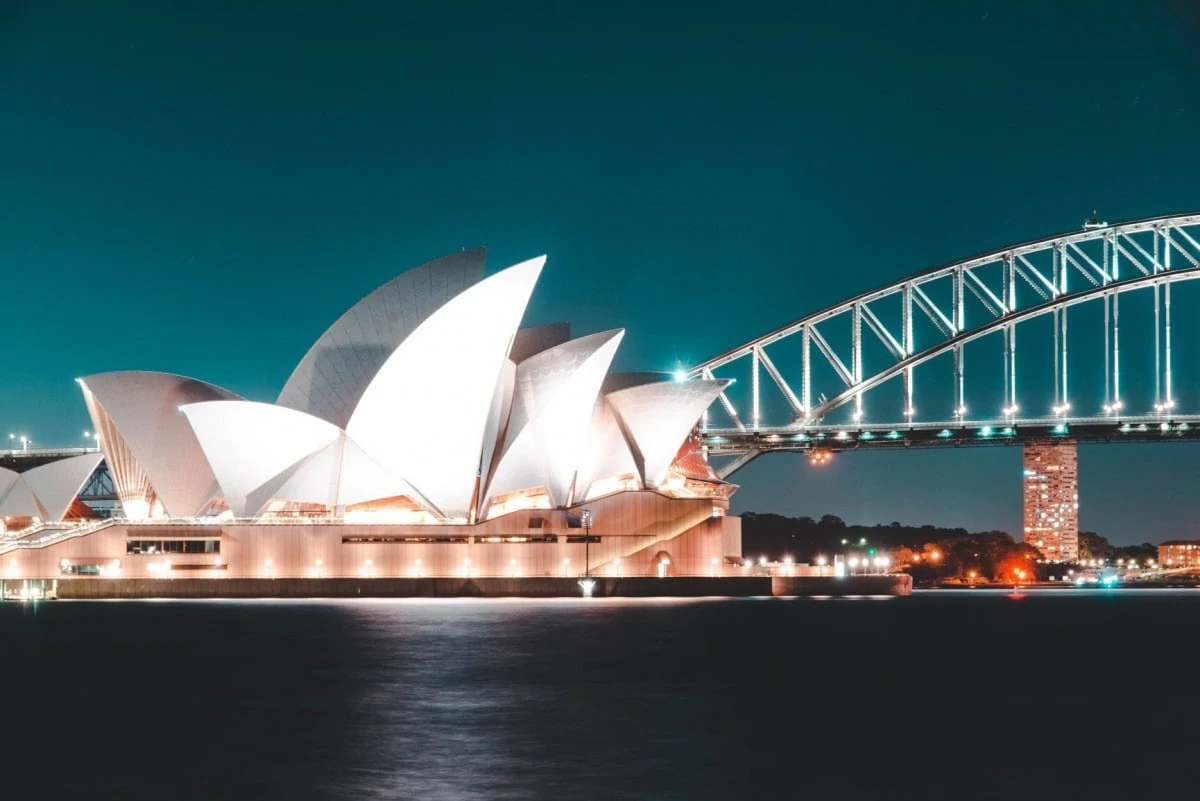
The only man-made structure that made it onto the list of world famous landmarks in Oceania (although many others were deliberated), the Sydney Opera House has to be the most iconic building in Australasia.
Designed by Jorn Utzon, as the winning design out of 233 entries into an international competition back in 1956, the concert hall was originally due to cost AUD$7 million but ended up costing more than AUD$102 million. Still worth every cent in our opinion.
Fun fact: Arnie (or Mr Schwarzenegger) won the last of his Mr Olympia titles at the Royal Albert Hall in 1980!
Check out some of the other buildings that we debated in our landmarks in Australia and landmarks in New Zealand features.
Natural landmarks
Great Barrier Reef
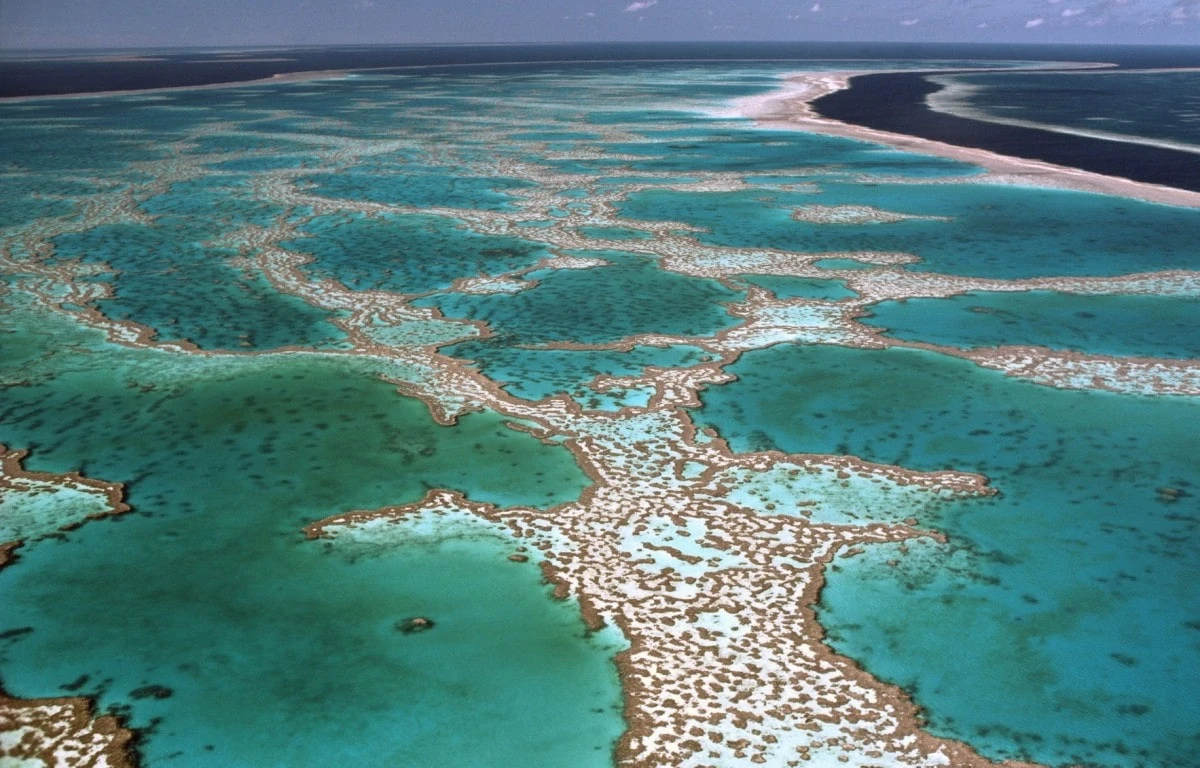
The world’s biggest single structure made of living organisms has to make it on the list, especially as it’s so big that it can be seen from space (unlike the Great Wall of China which cannot) the Great Barrier Reef is synonymous with the land ‘down under’.
As passionate divers and lovers of all things wildlife, the largest coral reef system in the world is just such an iconic place that it had to be in the article. And given that it’s home to 1,500 different types of whales, dolphins, turtles, sharks, rays and other fish – let alone all the coral, it’s an underwater paradise.
Another natural wonder of the world, the Great Barrier Reef is technically 3,000 individual reefs and over 900 islands that cover an area of 350,000 square km. That’s like putting together the UK, The Netherlands and Switzerland and then adding a little more…
Uluru
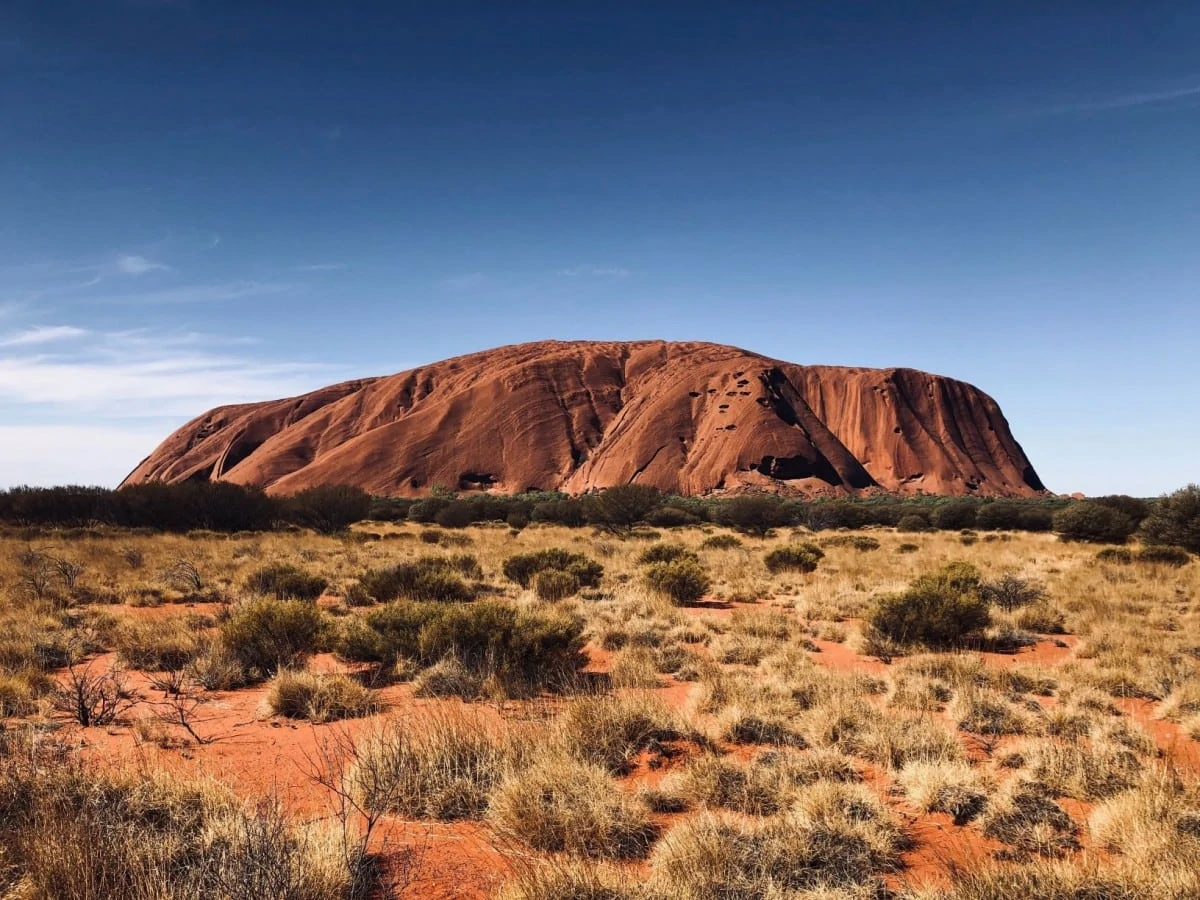
And the final landmark to make it onto our Australasian section is Uluru, also known as Ayers Rock, one of the most famous natural rock formations on earth.
Located in the Uluru Kata Tjuta National Park, this massive sandstone rock formation is a hugely important and sacred place for the Aboriginal people in Australia.
Rising up to a height taller than the Eiffel Tower at 348 metres, and estimated to weigh almost 1.5 billion tonnes, this formation appears to rise out of nowhere. But even more impressive is that the 600 million year old rock continues much further underground!
Europe
Man-made landmarks
Eiffel Tower
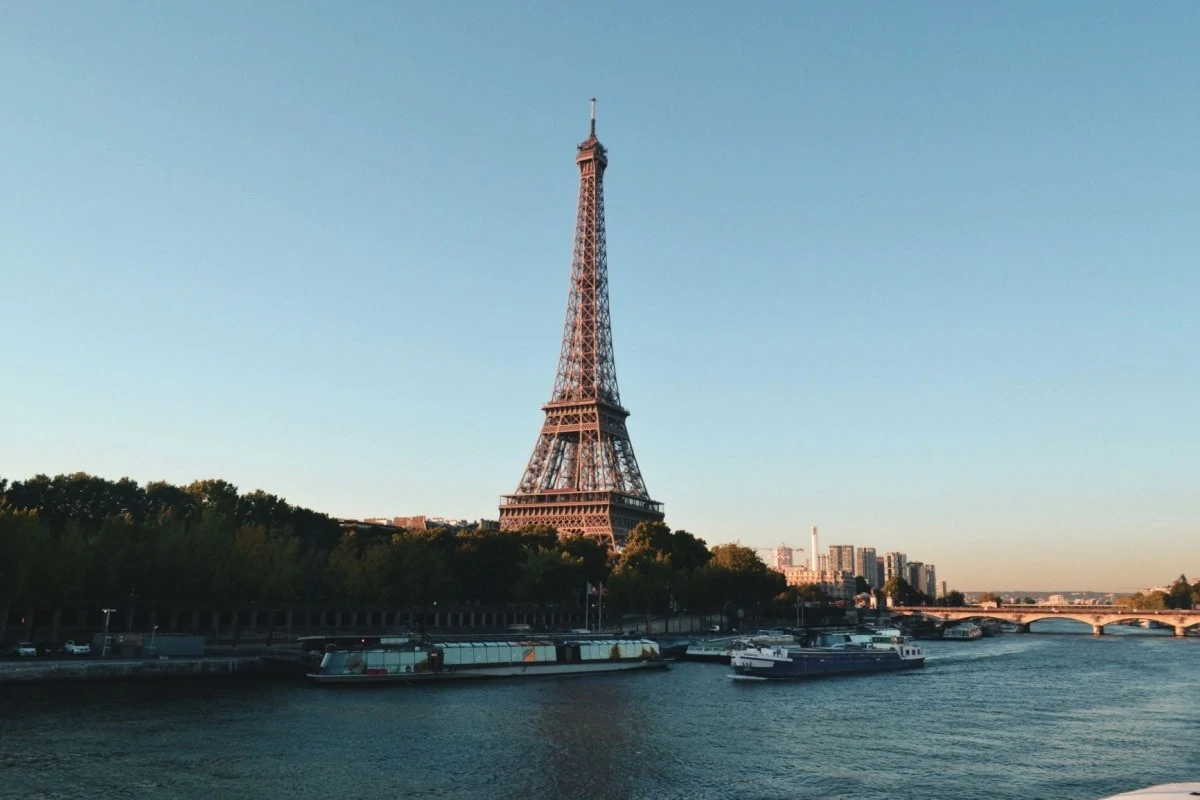
The most famous landmark in France and we believe the most famous metallic structure on the planet, most people don’t realise that the Eiffel Tower was originally constructed as an entrance to the 1889 world fair.
Named after the engineer whose company built the structure, Gustave Eiffel, completed within in two years which we think is impressive enough, the iconic tower held the title of the tallest structure on earth for over 40 years. Ok so not as impressive as the pyramids, but still not a bad reign as world’s tallest…
Fun fact: The lifts that ferry tourists up and down the Eiffel Tower will between them cover a distance in one year that is the same as travelling around the globe 2.5 times!
Colosseum
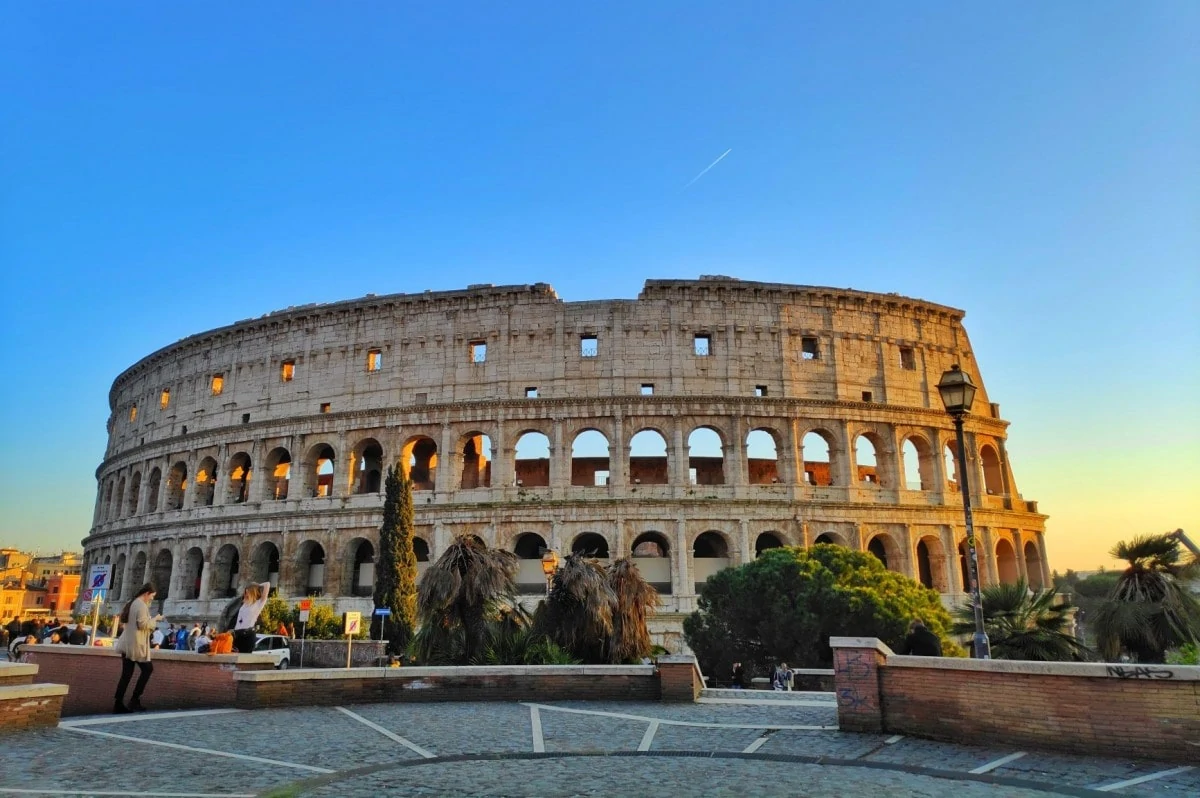
Estimated to seat between 50,000 and 85,000 fanatical fans, all wanting to watch their favourite gladiator battle to the death, the Colosseum would stand as one of the bigger stadiums in Europe even today. And yet, this marvellous feat of construction was built almost 2,000 years ago. Madness.
Strangely not included in the original list of Wonders of the World (well not that strange as it wasn’t built by then), this iconic landmark in the heart of Rome was included in the updated New 7 Wonders of the World list. Rightly so.
Construction started on the Colosseum during the reign of Emperor Vespasian and completed under Emperor Titus in 80 AD, the amphitheatre is 189 metres long by 150 metres wide, making it the largest of its kind in the world.
We should probably mention that there are so many other amazing structures and famous landmarks in Europe, just we couldn’t agree on what should be in… whether it’s the Sagrada Familia in Barcelona, Tower Bridge arguably our favourite famous landmark in London, or even the Berlin Wall in Germany, there’s just an endless list and we had to limit it somehow…
Here’s some of the amazing landmarks that made it onto our list of most amazing landmarks in England.
Natural landmarks
The Northern Lights
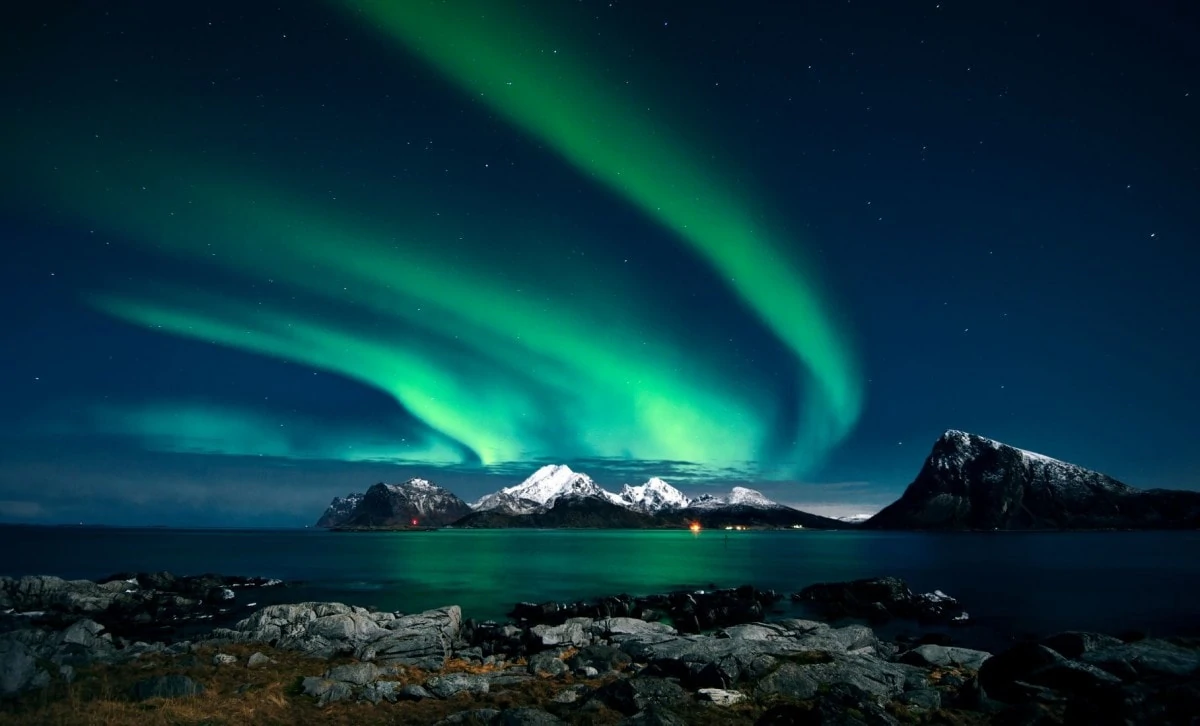
Whether you’re in Iceland, across Scandinavia or anywhere really up towards the Arctic circle, during the winter months if you get a clear night, you’re more than likely to see one of the world’s great phenomena: the Aurora Borealis or Northern Lights.
Caused by solar winds disturbing the magnetosphere, the night’s sky can be lit up of a dance of colours, although most prominently green and then red.
For us, this has been right at the top of the bucket-list for a few years; something we need to change… Have you experienced this amazing phenomenon? Let us know about your experiences in the comments below.
The Norwegian Fjords
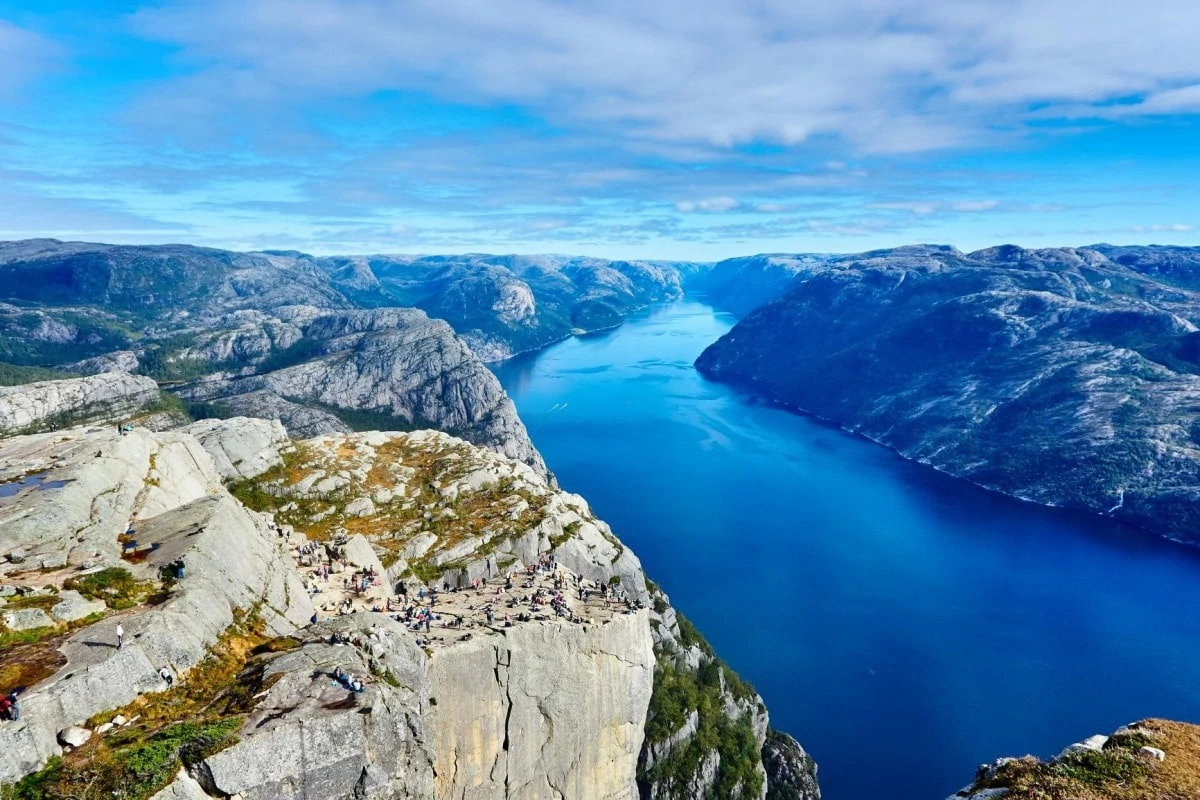
There are so many beautiful natural landmarks in Europe, everything from mountains like Mont Blanc and the Matterhorn, rock formations like the Giant Causeway in Ireland through to idyllic lakes like Bled in Slovenia and Plitvice in Croatia, but for our final entrant we both agreed should be the stunning Fjords of Norway.
Formed by giant glaciers grinding away at the landscape they once flowed over, the Fjords are long waterways with a narrow opening out to the seas, surrounded on three sides by steep cliffs.
Norway boasts two of the longest Fjords in the world, as well as Pulpit Rock, a spectacular mountain plateau that looms over 600m above the Lysefjord.
North America
Man-made landmarks
Golden Gate Bridge
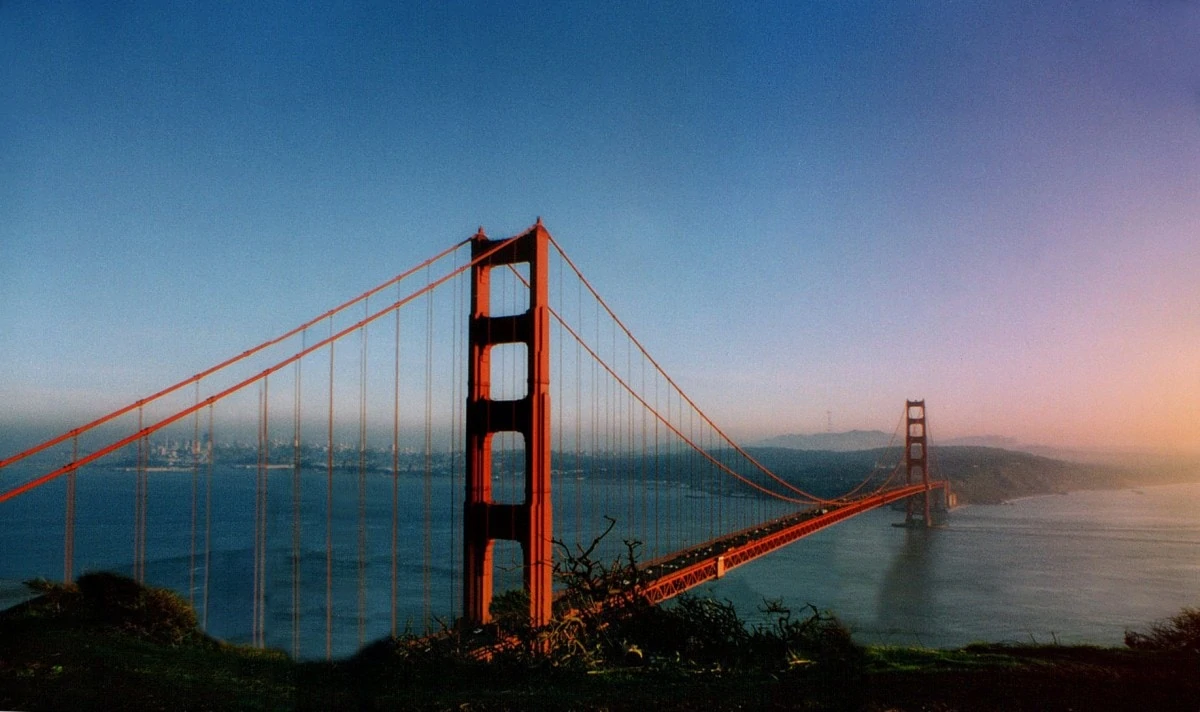
Quoted as ‘being one of the most photographed bridges in the world’, the Golden Gate Bridge is one of the most recognisable landmarks in the United States of America.
Designed by Joseph Strauss in 1917, it took another 20 years before the bridge would be completed (although it only took 4 years to build), and when opened in 1937 was the tallest and longest suspension bridge in the world.
Constructed as a way to connect San Francisco to Marin County, the bridge takes its name from the strait between the Pacific and the San Francisco Bay – the Golden Gate Strait.
Fun fact: The bridge was never meant to be orange in colour, the US Navy had petitioned for it to be blue and yellow so it would stand out, but the orange paint was the primer added to the metal before delivery, and the overseeing architect liked it so much that it stayed.
Statue of Liberty
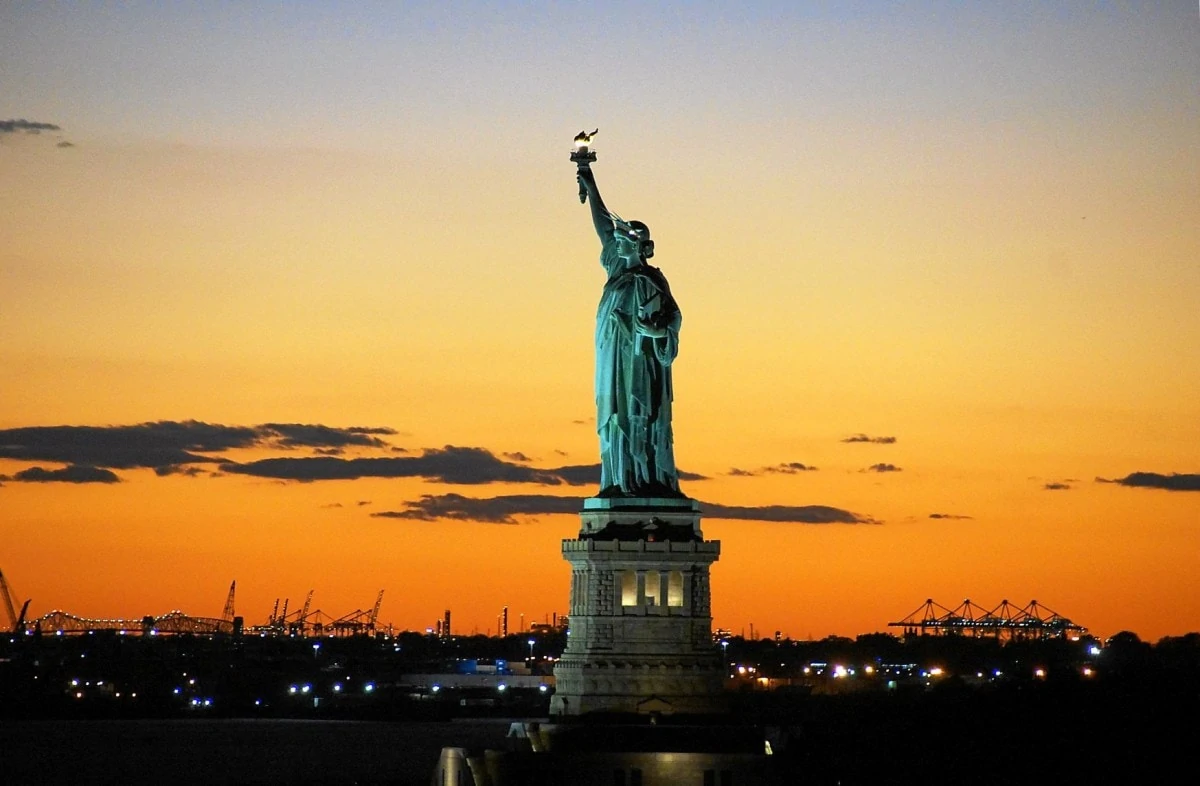
Nothing says freedom, prosperity and welcome to the USA like seeing the Statue of Liberty! Standing proud on Liberty Island in New York Harbour, the beautiful copper statue was a gift from the people of France to the Americans.
With the frame built by Gustave Eiffel (yep, that chap who did the tower), and designed by Frederic Bartholdi, the statue depicts the Roman Goddess of Freedom, Libertas. Her arm aloft with the famous torch, a tablet inscribed with 4th July 1776 to signify Independence Day, and broken shackles at her feet to commemorate the abolition of slavery.
Fun Fact: Even though the Statue of Liberty is covered by a thin layer of colour, it appears green due to oxidation that has happened over the years.
Natural landmarks
Grand Canyon
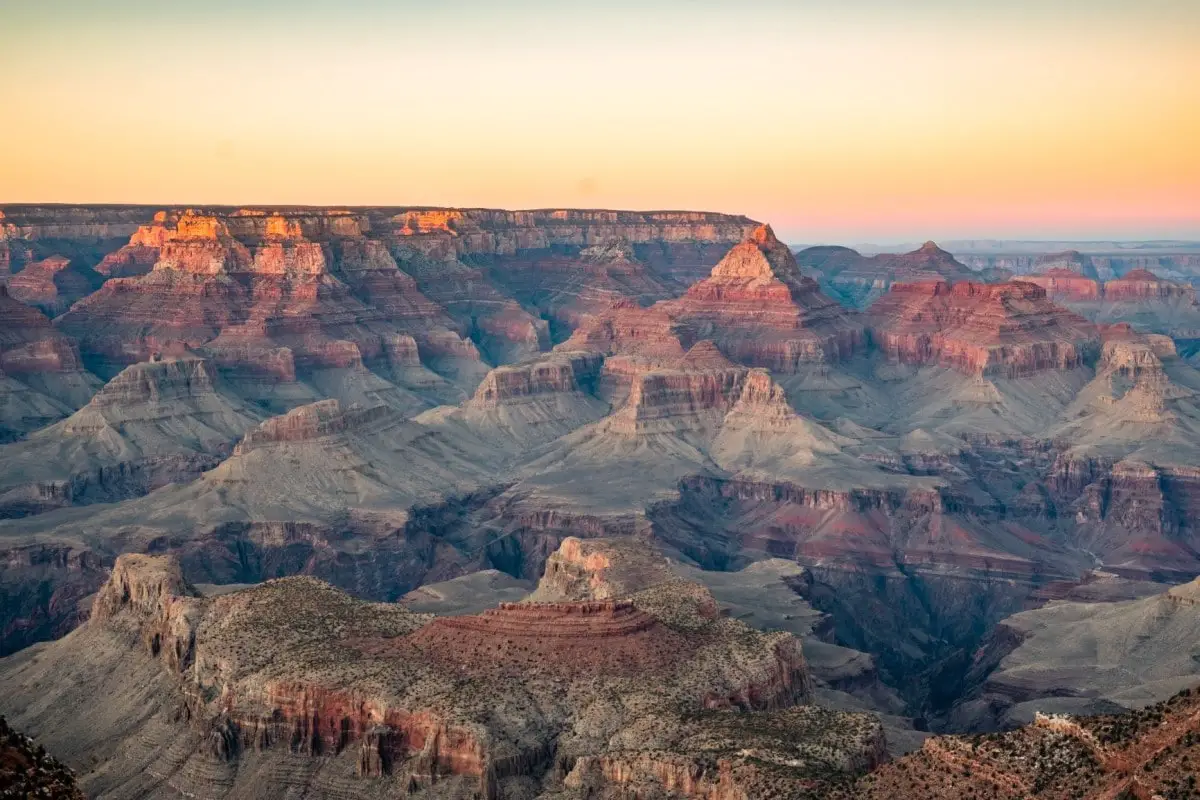
We have the Colorado River to thank for creating one of the most beautiful landmarks in the Americas, as over the last 6 million or so years it has been carving away at the rock to create the amazing canyon that is recognised around the world today.
The Grand Canyon is massive. The steep sided canyon is close to 450km long (270 miles), 30km wide (18 miles) and at it’s deepest is almost 2km down! Although it isn’t the biggest in the world, we’d definitely say it’s the most famous and why it needs to be on the list.
Yellowstone National Park
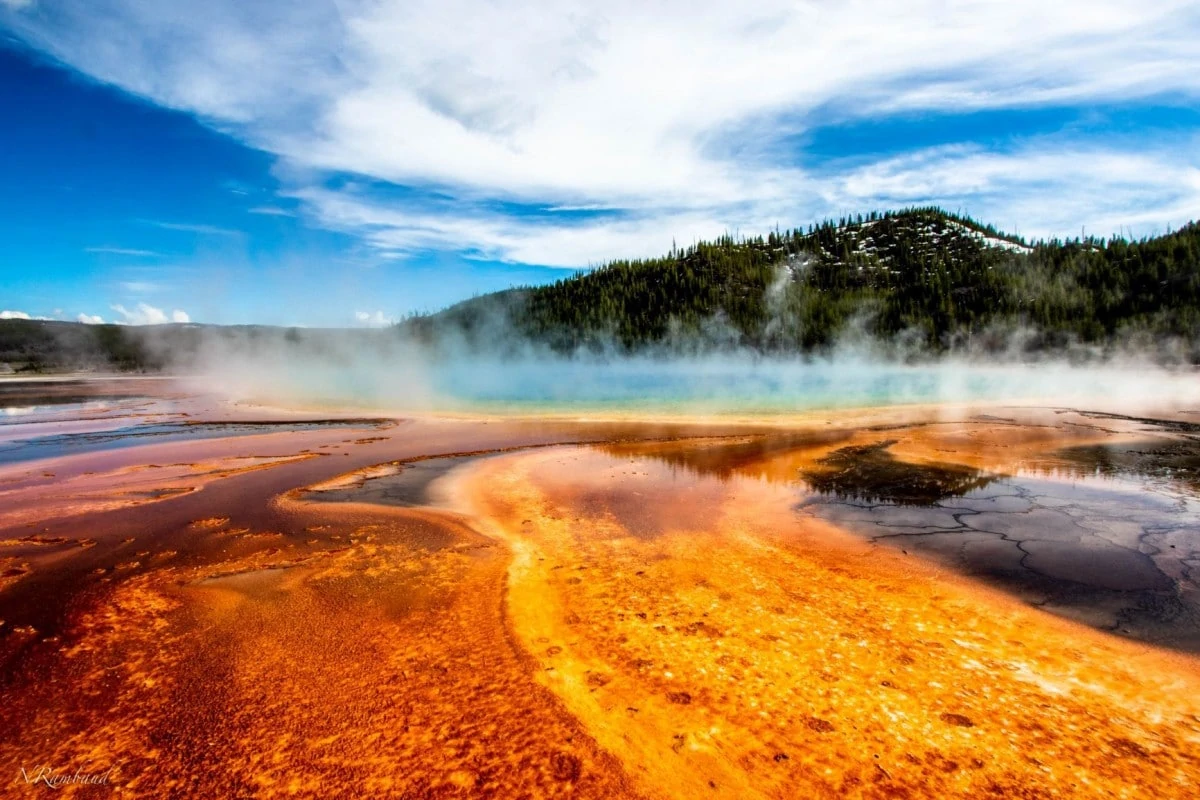
Covering parts of Idaho, Montana and Wyoming, (well 96% of if falls into the latter), Yellowstone is the oldest National Park in the US, and was established way back in 1872.
The park is on the site of a super-volcano, the Yellowstone Caldera with which comes over 10,000 hydrothermal features, including the Old Faithful geyser which would hit many famous landmarks lists in its own right.
And the stats of the Yellowstone National Park are insane: 300 active geysers, 290 waterfalls, around 1000 miles of hiking trails, 67 species of mammals, 285 of birds and it covers an area of around 2.2 million acres!
Our top tip: Try and visit Yellowstone in September. It’s less crowded than the busy summer months of July and August so you can get great deals…
Niagara Falls
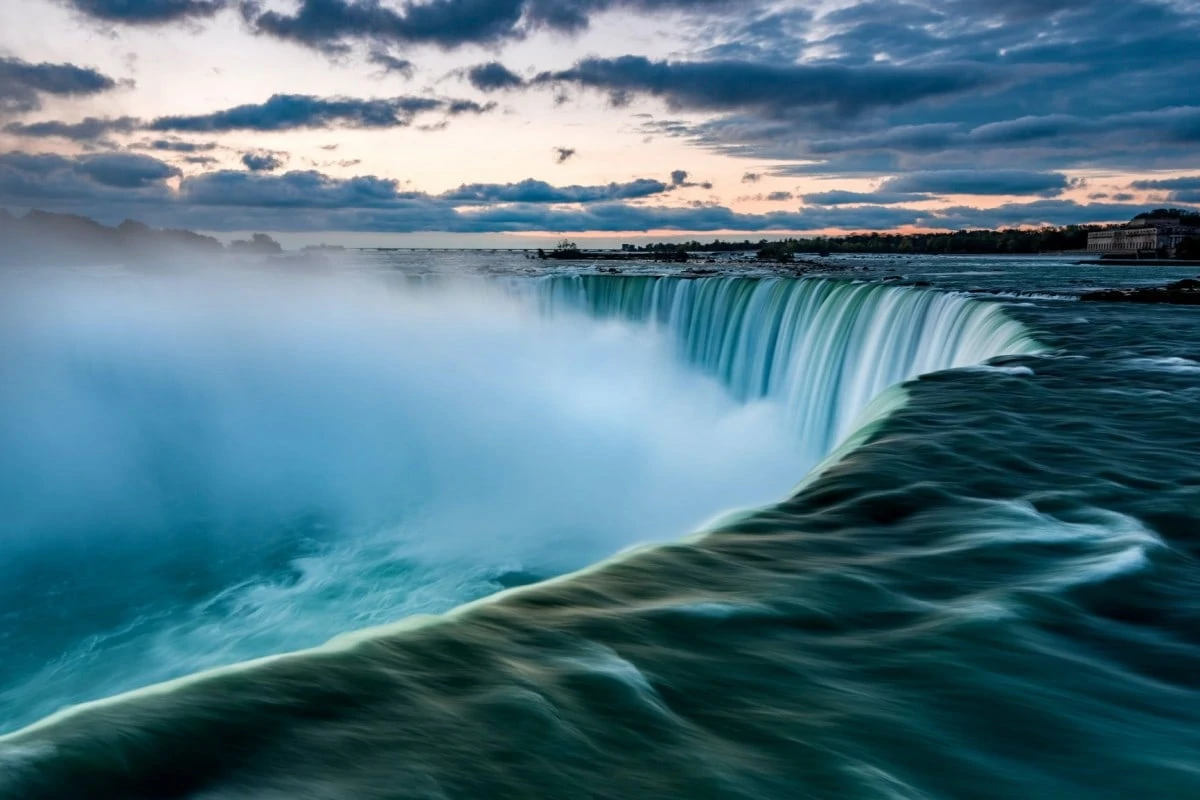
We’d punt that Niagara Falls is the most famous waterfall in the world. It’s not the widest or tallest, but this three-part waterfall packs a serious punch, with the three falls’ combined flow rate the largest in the world.
The three waterfalls that make up Niagara are the American Falls, the Bridal Veil Falls and the Horseshoe Falls. With the latter on the Canadian side being the largest of them and a flow rate of a ridiculous 2.2 million litres a second…
Fun fact: The Niagara Falls are not very old at all! The river only started flowing around 12,000 years ago at the end of the last Ice Age, with water leaving the newly formed Great Lakes.
Middle East
Man-made landmarks
Petra
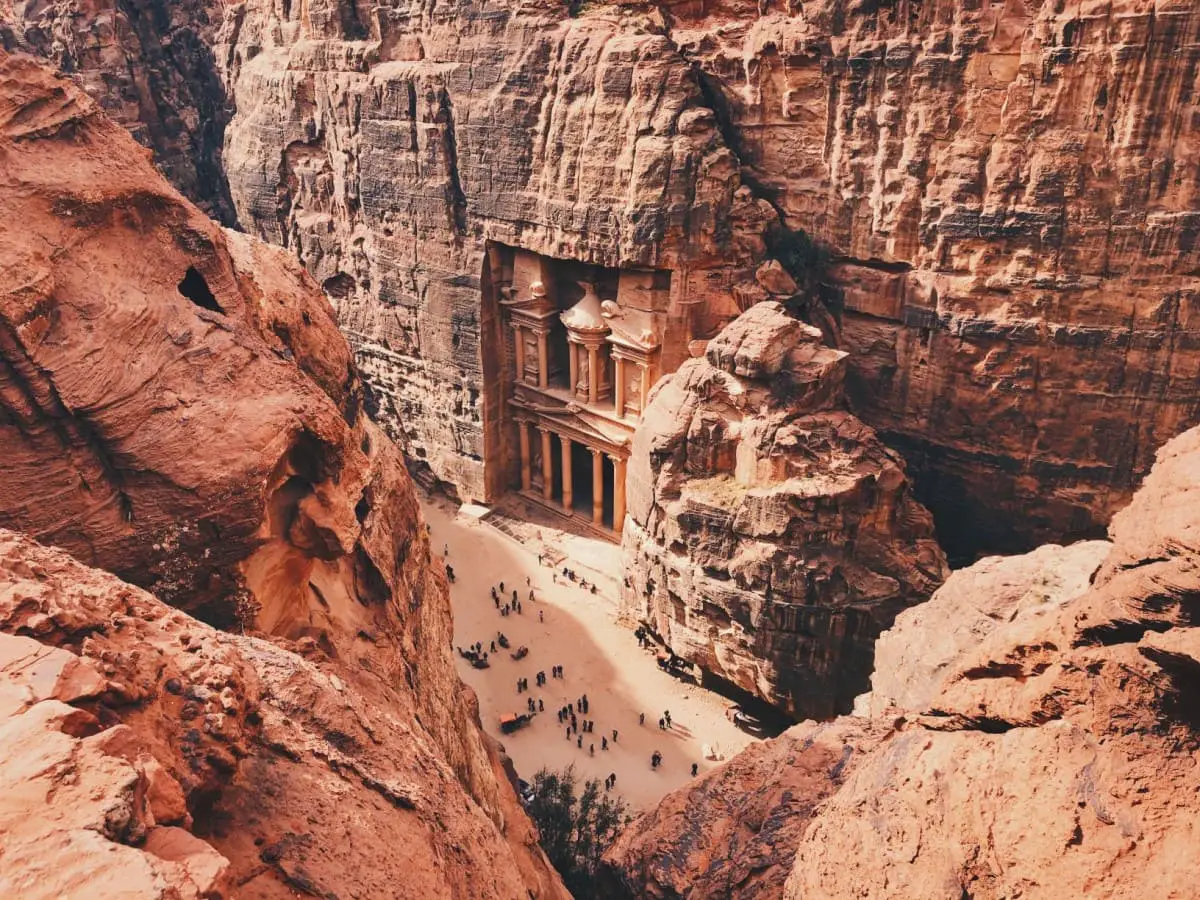
Another of the famous landmarks that was named as part of the New Wonders of the World, Petra is a fascinating historical city in Jordan.
Built by the Nabateans, nomadic Arabs in around the 4th century BC, Petra became a major trading centre between Egypt and the Arabian Peninsula. Although Petra was mainly used as a city, it is often mistaken as just a burial ground as there are over 1,000 tombs, with many of the most elaborate carved building mausoleums of important figures.
Burj Khalifa
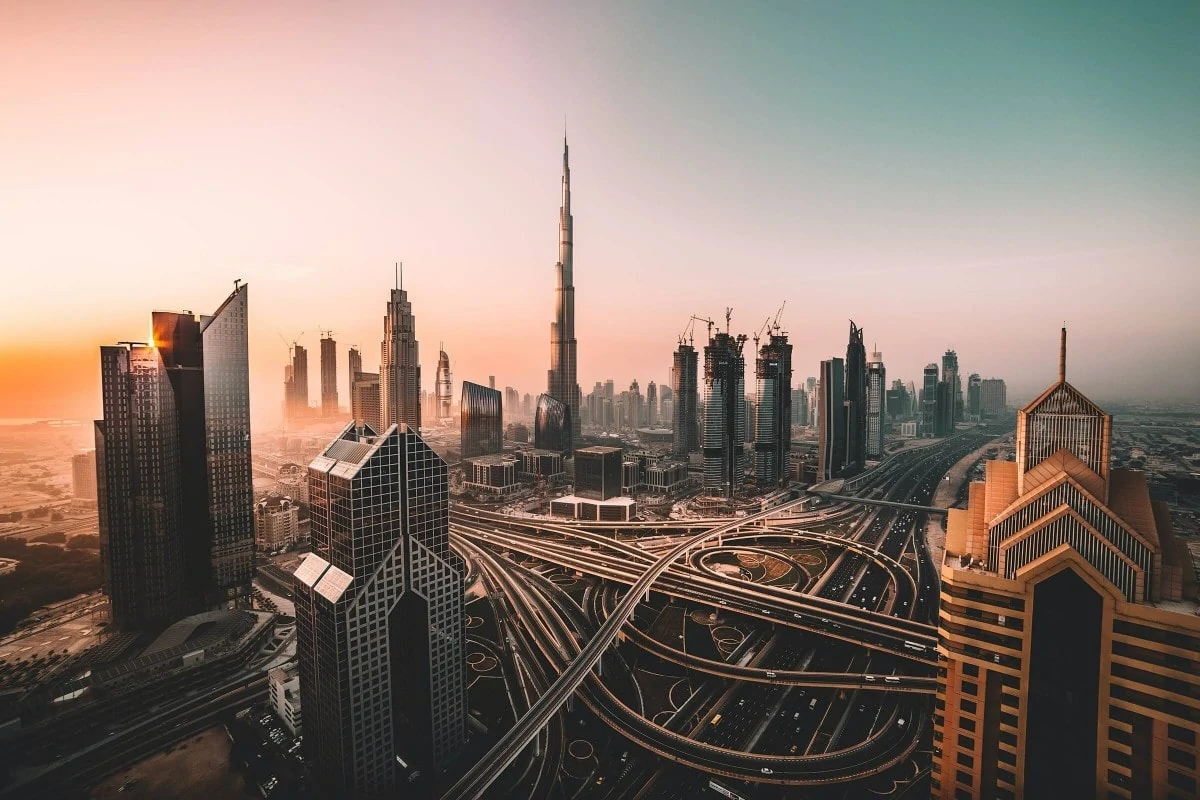
Of course the tallest building in the world has to make it onto the list of most famous landmarks in the world… nearly everyone has heard of it, and knows where it is.
The Burj Khalifa is a record-breaking feat of engineering and at 829.8m tall (that’s more than 2,000 ft), it has been the tallest building on the planet for a decade. It is going to stand as the tallest building for a few more years – until the Jeddah Tower opens which is expected to be more than 1km tall!
Fun fact: The Burj Khalifa has over 24,000 glass panels that cover around 120,000 square metres and cleaning it from start to finish takes the team of around 36 cleaners between 3 and 4 months. So, as soon as they finish, they start again. Quite literally a never-ending job.
Natural
The Dead Sea
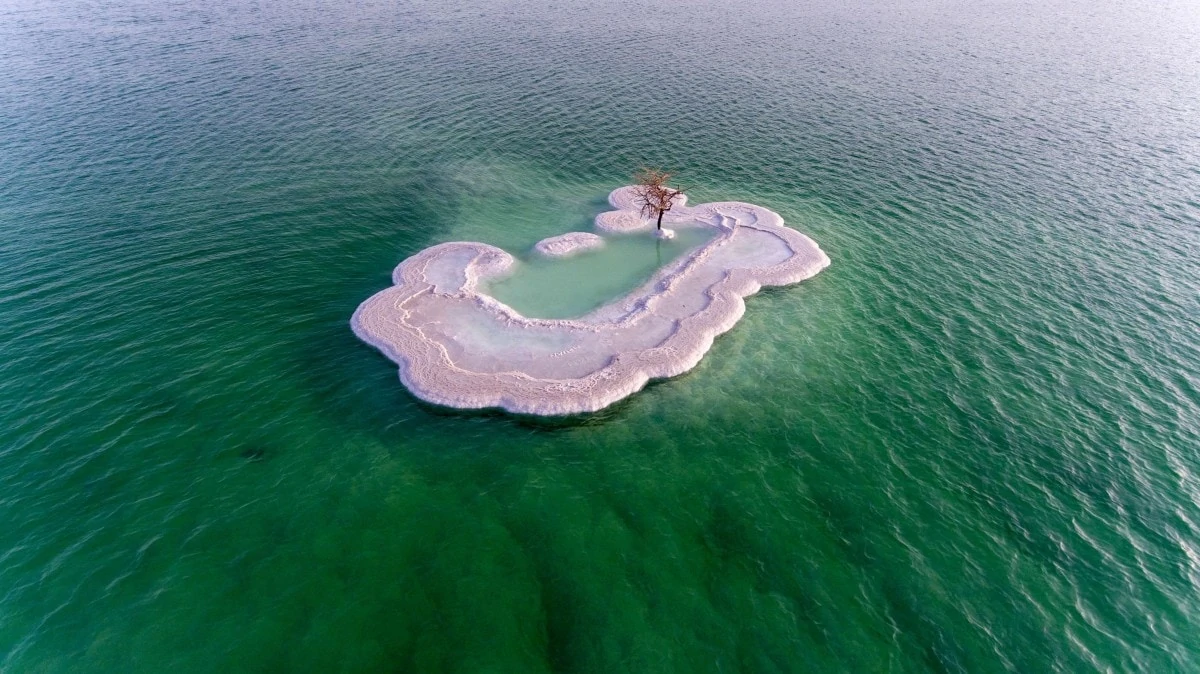
Potentially the strangest natural landmark to make it on our list has to be the Dead Sea. The salt lake between Israel and Jordan really is unlike anywhere else on earth.
Thought to have been formed by the movement of tectonic plates, the lake used to be connected to the Mediterranean Sea. But with the lake cut off, extremely low rainfall and heat continually evaporating the surface water, the lake has gotten lower. In fact, so low, that the banks of the lake are the lowest point on land, anywhere in the world, at around 430m below sea level.
With a salinity of around 34%, the Dead Sea is around 10 times saltier than most other seas and oceans around the world – meaning that life doesn’t really exist in this body of water, except for the odd bacteria that is.
A truly unique natural landmark on earth.
South America
Man-made landmarks
Machu Picchu
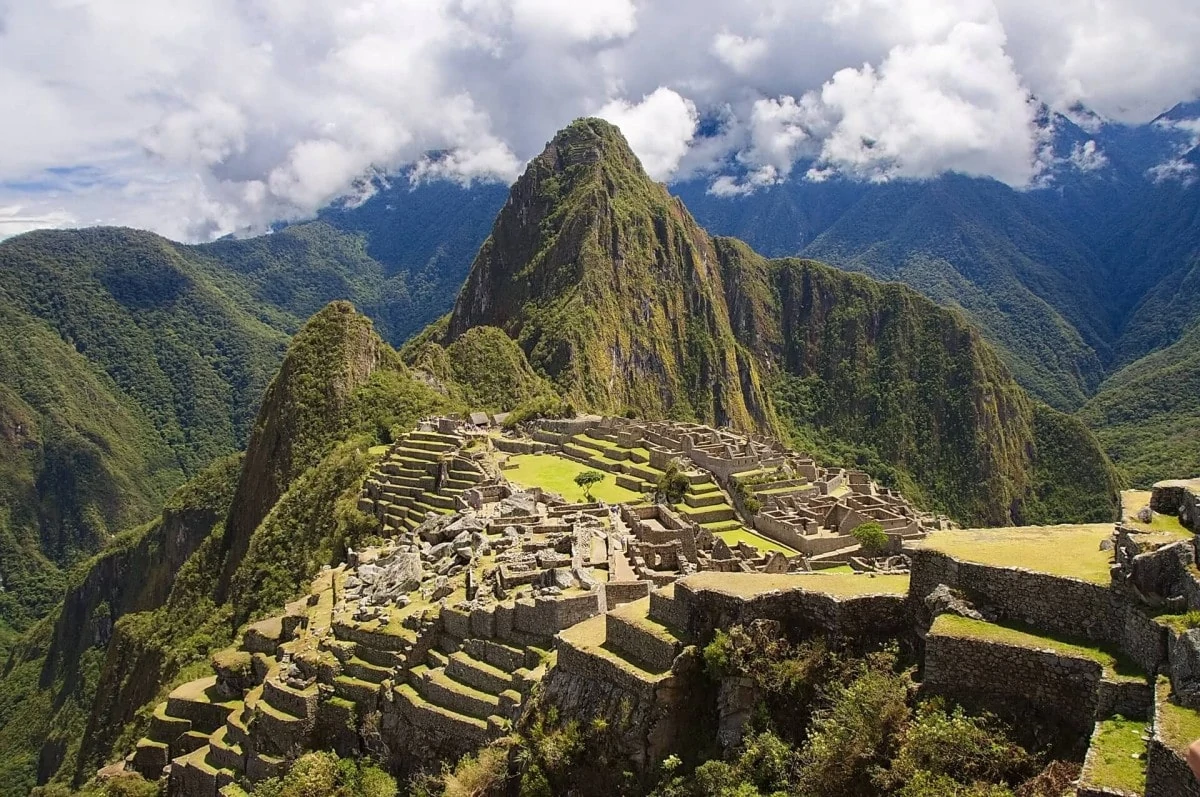
A city created in the 1400s by the Incas, Machu Picchu has provided inspiration to travellers and explorers for years as an iconic lost city.
Perched high in the Andes Mountains, the site was abandoned around 100 years after it was built during the time of the Spanish Conquest. Machu Picchu remained ‘lost’ for hundreds of years, and although known by locals, was only re-discovered and shared with the world by American Historian Hiram Bingham in 1911!
Check out which landmarks make our ultimate list of South American landmarks.
Easter Island statues
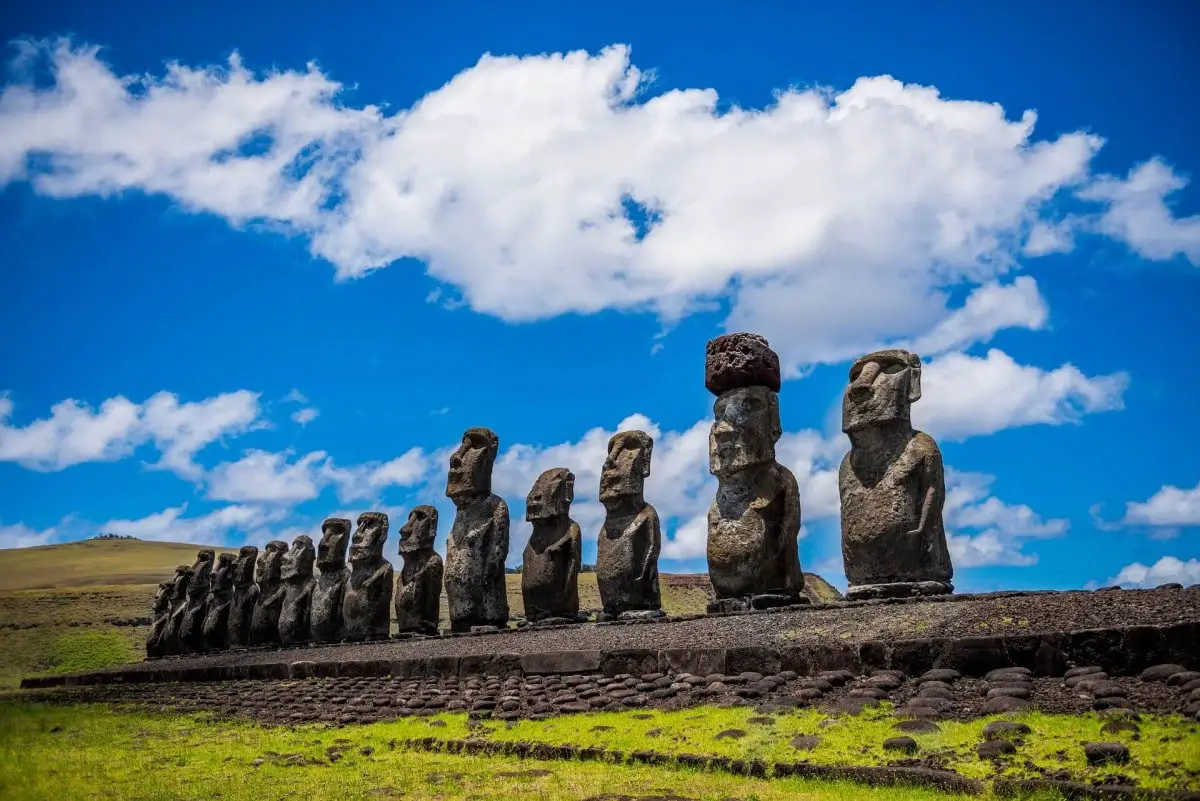
If you ever see a photo of these stone statues, you know exactly where it is from, yet, this small island in the middle of the Pacific Ocean is miles from everywhere.
The legendary statues, known as ‘moai’ to the locals, were carved and erected in honour of the inhabitants, the Rapa Nui’s, ancestors. While photos usually just show a few of these fascinating sculptures, there are actually over 887 dotted across this island outpost.
Unfortunately, the carvings had a more sinister impact since most of the trees on the island were felled in order to transport the massive monoliths to their resting places. This meant huge deforestation and a resulting civil war, over a lack of resource, thereby decimating the population.
Panama Canal
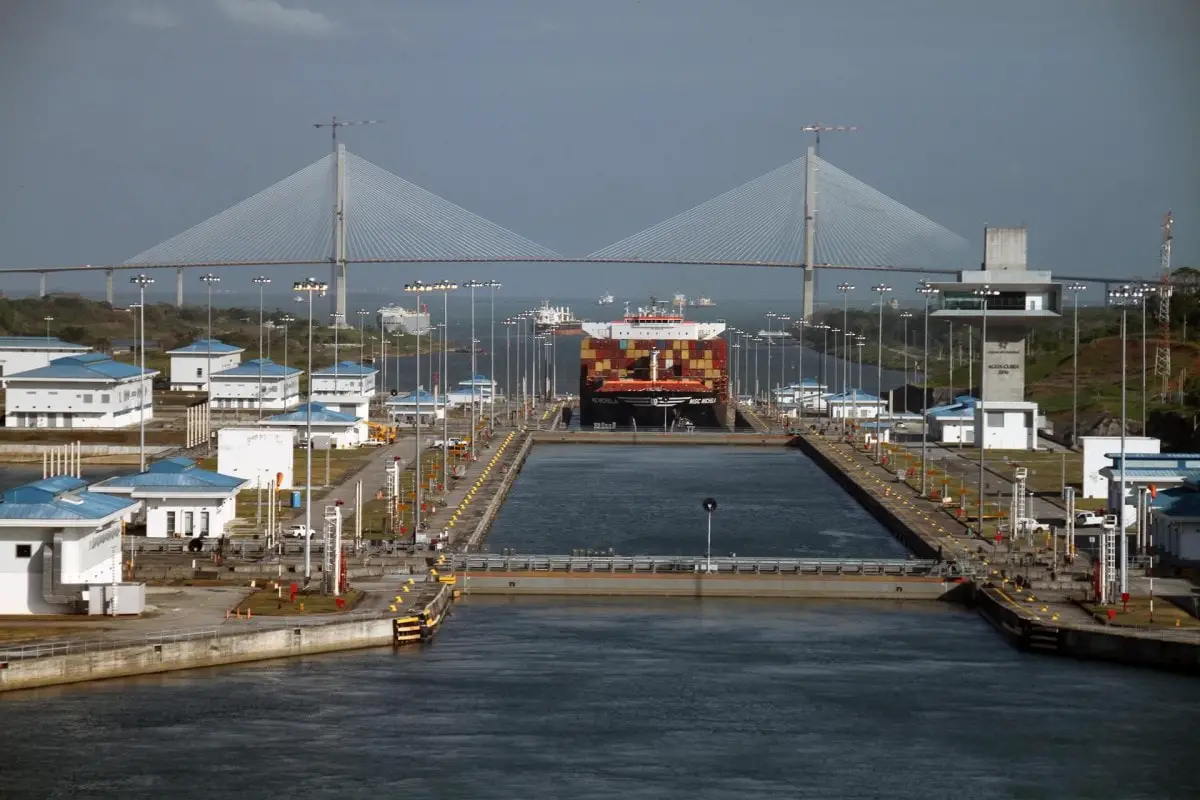
Another one of those that caused a few discussions, as we weren’t sure whether to include the Panama Canal or the Suez Canal, given both are extremely important man-made landmarks, that provide vital short cuts between pivotal trade routes. However, with the engineering that is behind the Panama Canal, with its lock system that raises enormous ships over 25 metres, it just takes the biscuit.
Built in 1914 by the United States, around 13,000 ships now use this waterway annually, vastly cutting down the time it takes to get from the Pacific to the Atlantic oceans. But they also pay handsomely for passage, with some of the largest vessels having to fork out USD$450,000 for the pleasure.
Christ the Redeemer
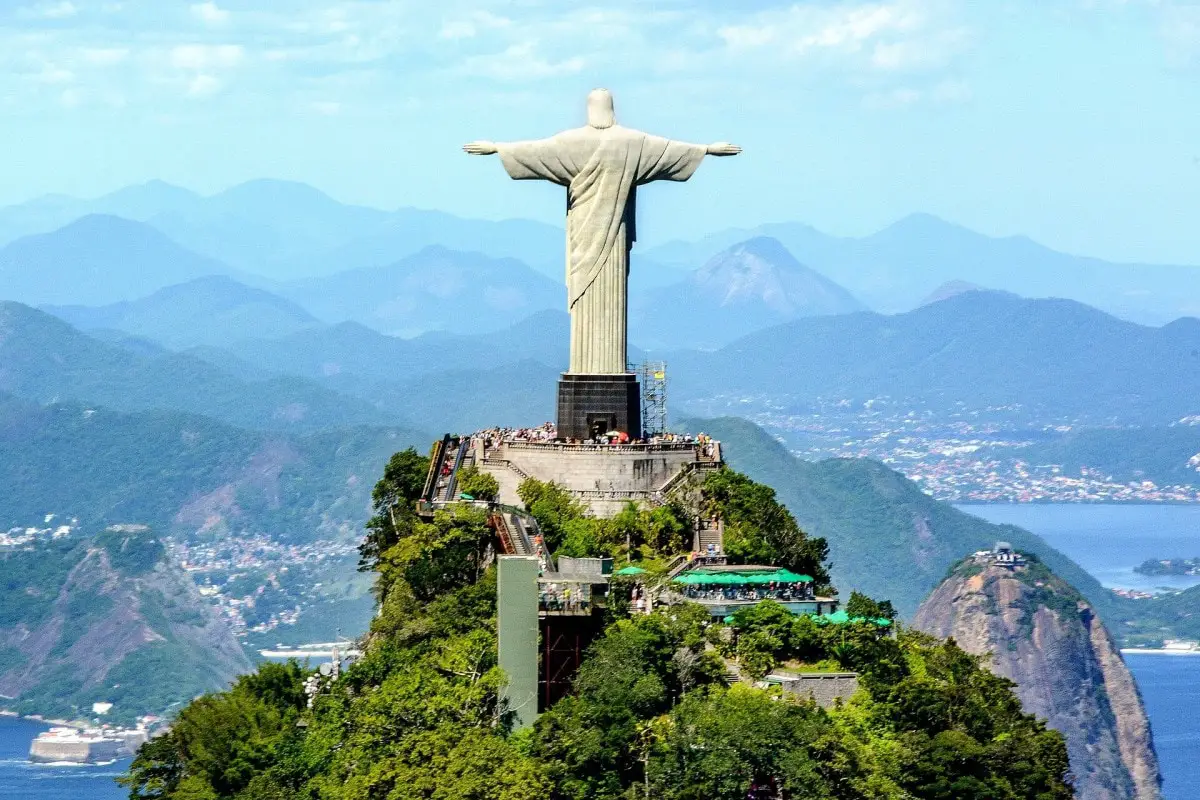
Looming over the city of Rio de Janeiro in Brazil, the Christ the Redeemer statue is one of the most iconic landmarks in South America, and alongside the Statue of Liberty, probably the most famous statue in the world.
Taking 9 years to build from 1922 and completed in 1931, this statue of Jesus is another that makes it onto the New Wonder of the Worlds. At 30 metres tall and an impressive arm-span of 28 metres, the Christ the Redeemer statue is a definite on our famous landmarks list.
Great fact: Property in Rio with a view of Christ the Redeemer is hugely sought after and commands much higher prices.
Natural landmarks
Amazon Rainforest
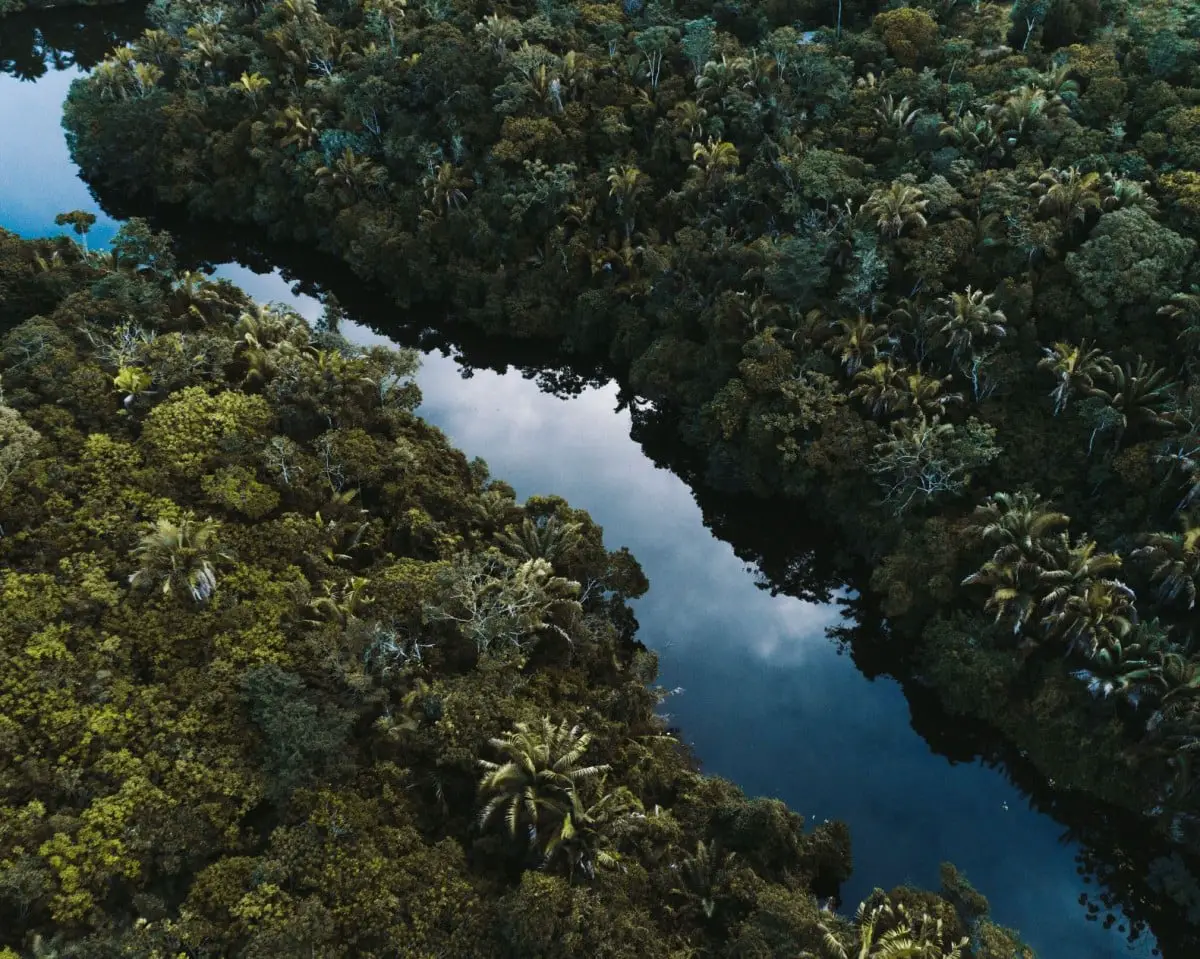
The Amazon Rainforest is the largest rainforest in the world, home to the Amazon River and named as the ‘lungs of our planet’, it really is one of the most important places on earth.
Covering an area of around 5.5 million square kilometres it is estimated to be home to 390 billion trees from 16,000 different species, 2.5 million insect species, 40,000 species of plants and thousands of birds and mammals. The numbers behind this famous landmark are so huge that it’s almost impossible to get your head around. But then again quite easy to see why it needs to be preserved.
Interesting fact: It is estimated that there could be as many as 50 Amazon tribes that have never had contact with the outside world.
Angel Falls
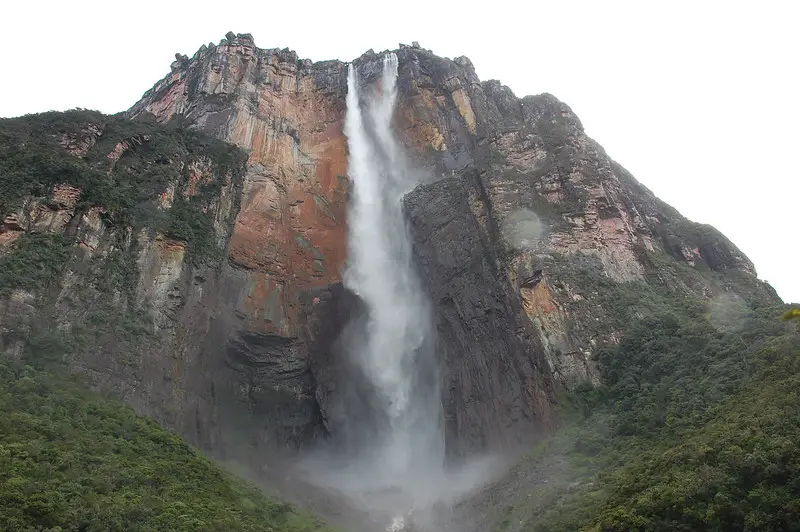
Photo credit: Ollie Harridge/Flickr
The third waterfall to make it onto our list of famous landmarks, and Angel Falls makes it for being the highest waterfall on earth.
Found in Venezuela, it falls from a height of 979 metres (that’s over 3,000 ft) off the flat-topped plateau known as Devil’s Mountain.
Fun fact: To give you an idea of the height of the waterfall – it’s around 3 times the height of the Eiffel Tower!
Uyuni Salt Flats
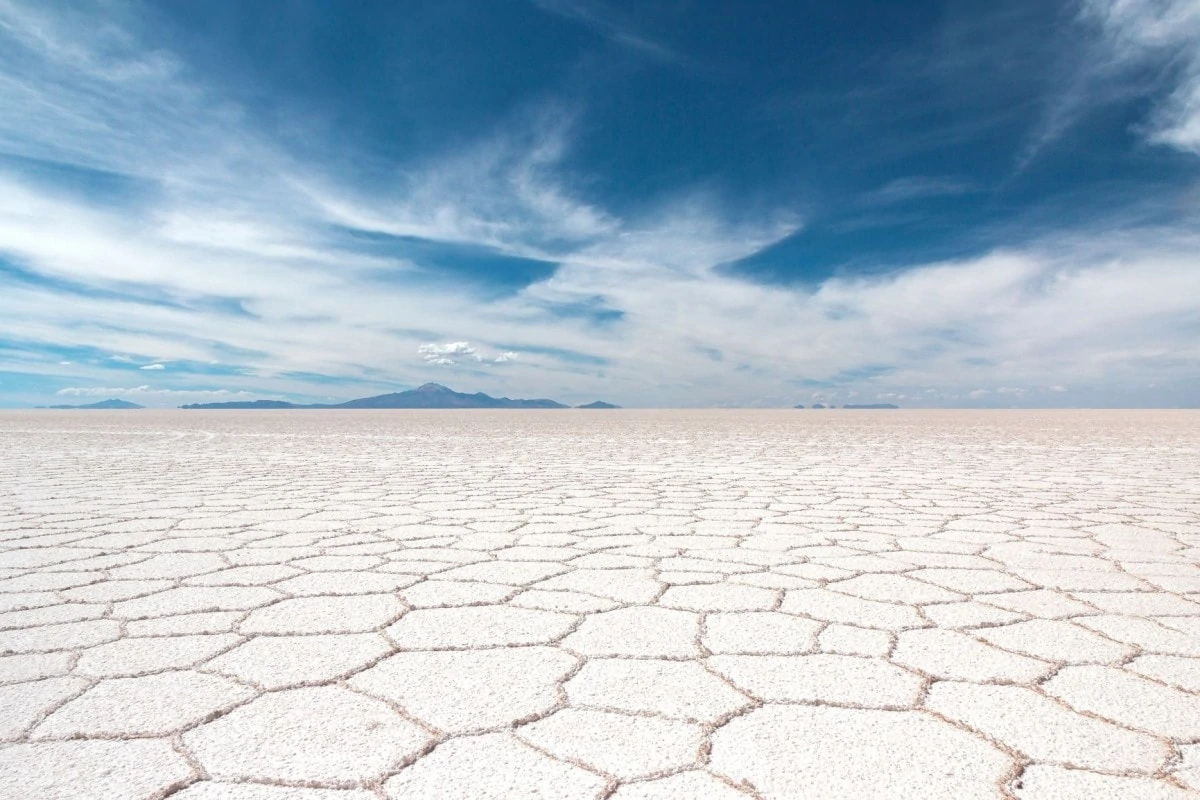
The Salar de Uyuni or Uyuni Salt Flats is the world’s largest salt plains, covering a ridiculous 10,000 square km (or nearly 4,000 square miles).
The salt flats, located in Bolivia, are estimated to contain at least half of the world’s known lithium and around 11 billion tonnes of salt!
After rain the salt flats take on a reflective appearance, and at 180 km wide, make it the largest ‘mirror’ on Earth.
Galapagos Islands
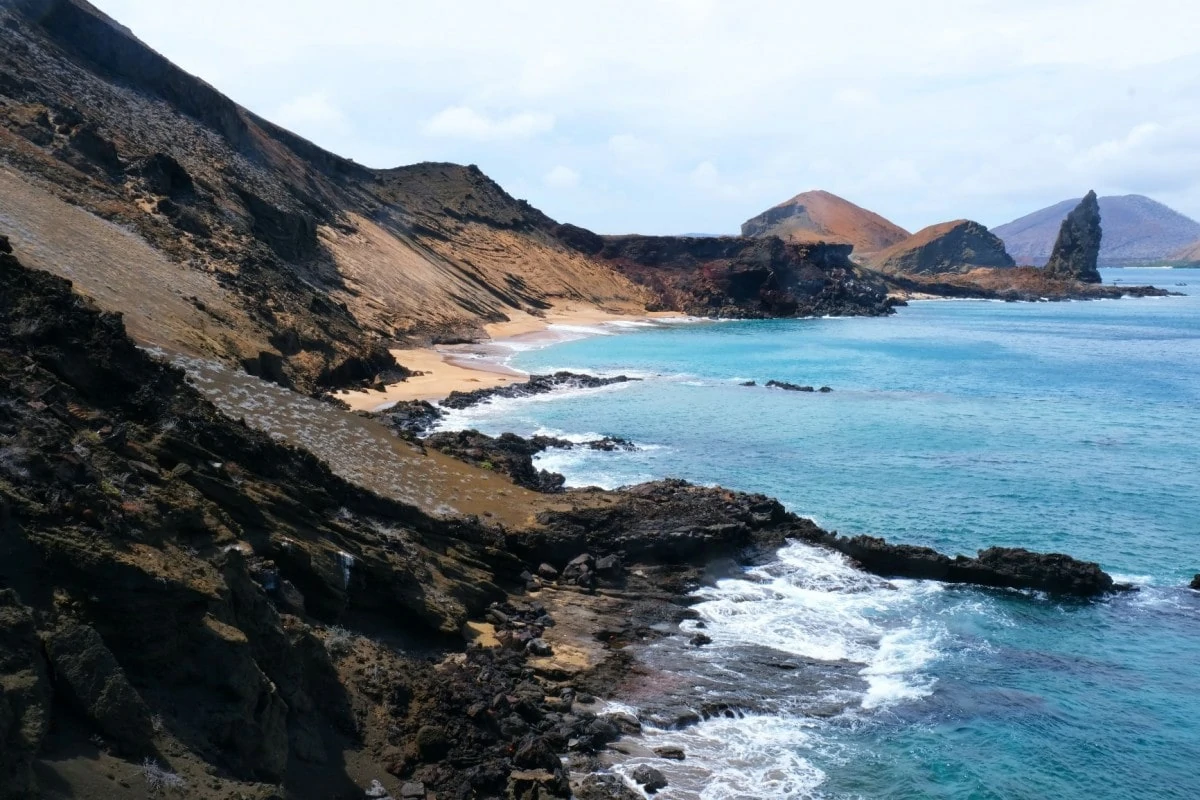
And finishing off our list of famous landmarks has to be the islands that led to (or at least very much sculpted) Darwin’s Theory of Evolution.
Darwin arrived into the Galapagos Islands in 1835 on the HMS Beagle, and thanks to his research and collection of species he realised that creature were perfectly adapted for their environments, which made up a sizeable part of his works On the Origin of the Species.
The Galapagos Islands, around 1000km off the coast of Ecuador, are now nearly all national parks, meaning that this really is one of the last pristine destinations and best naturally preserved places on the planet.
So, what do you think about our list of famous landmarks from around the world? Let us know in the comments below if you think we’ve missed any off!
Want to save this for later? Why not pin it…
